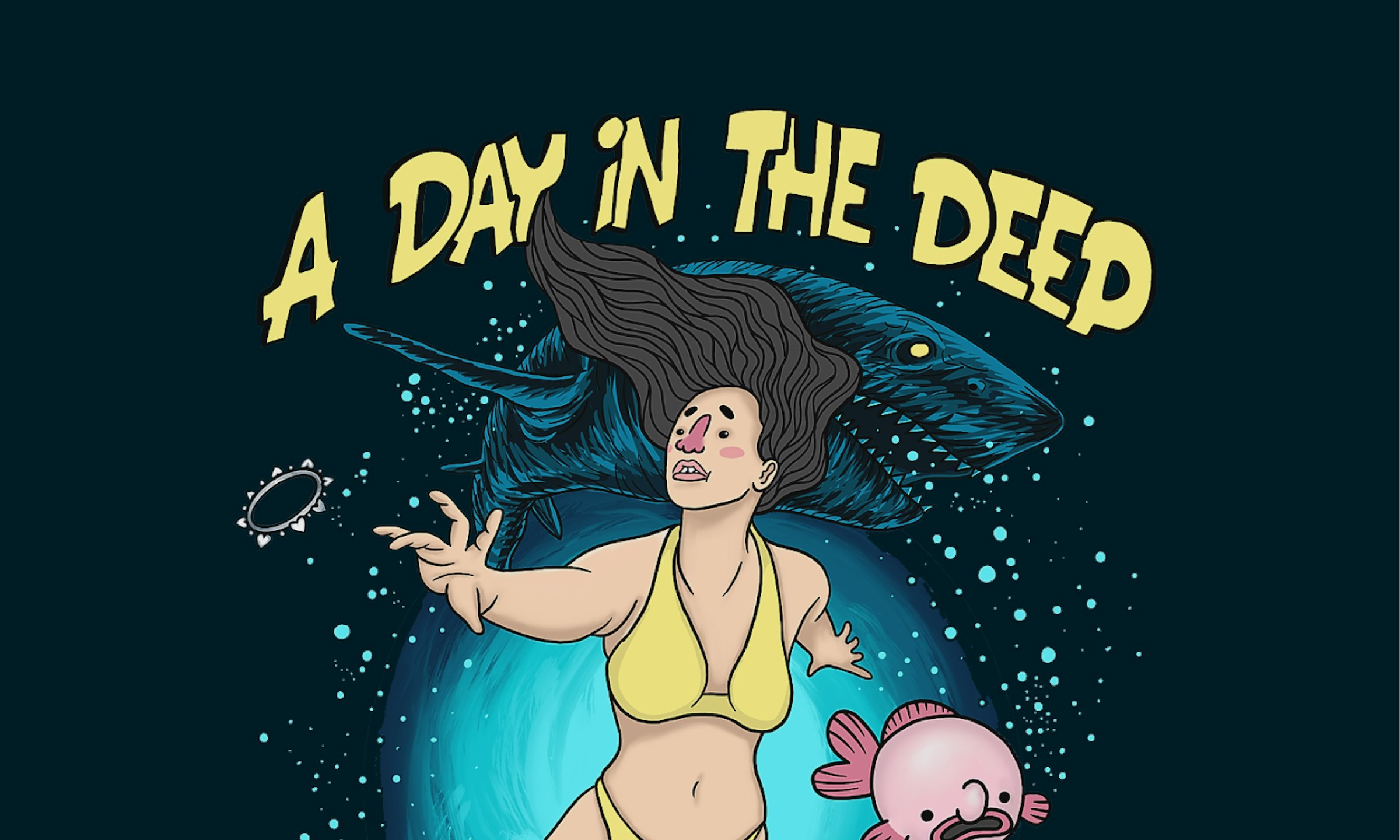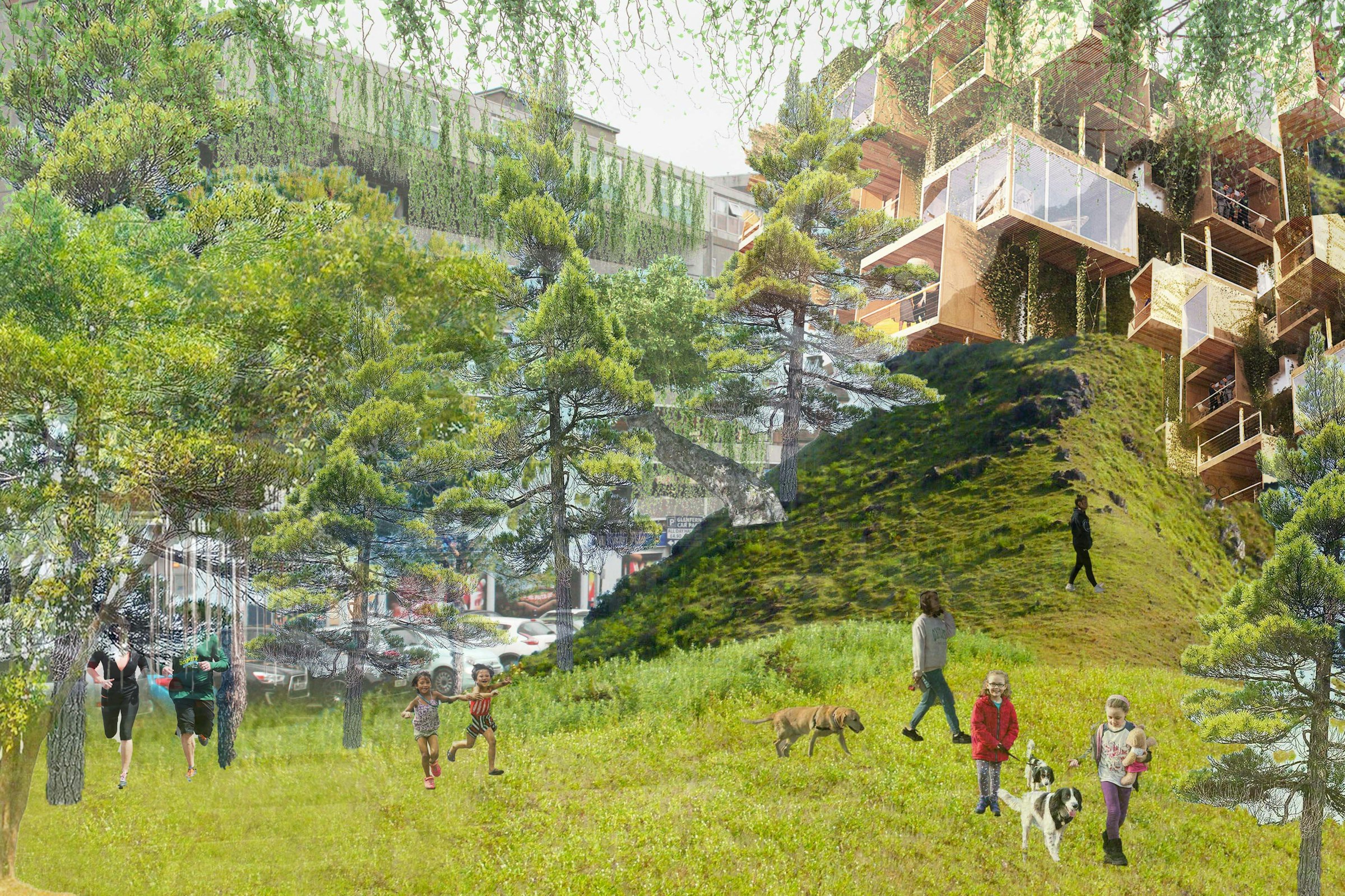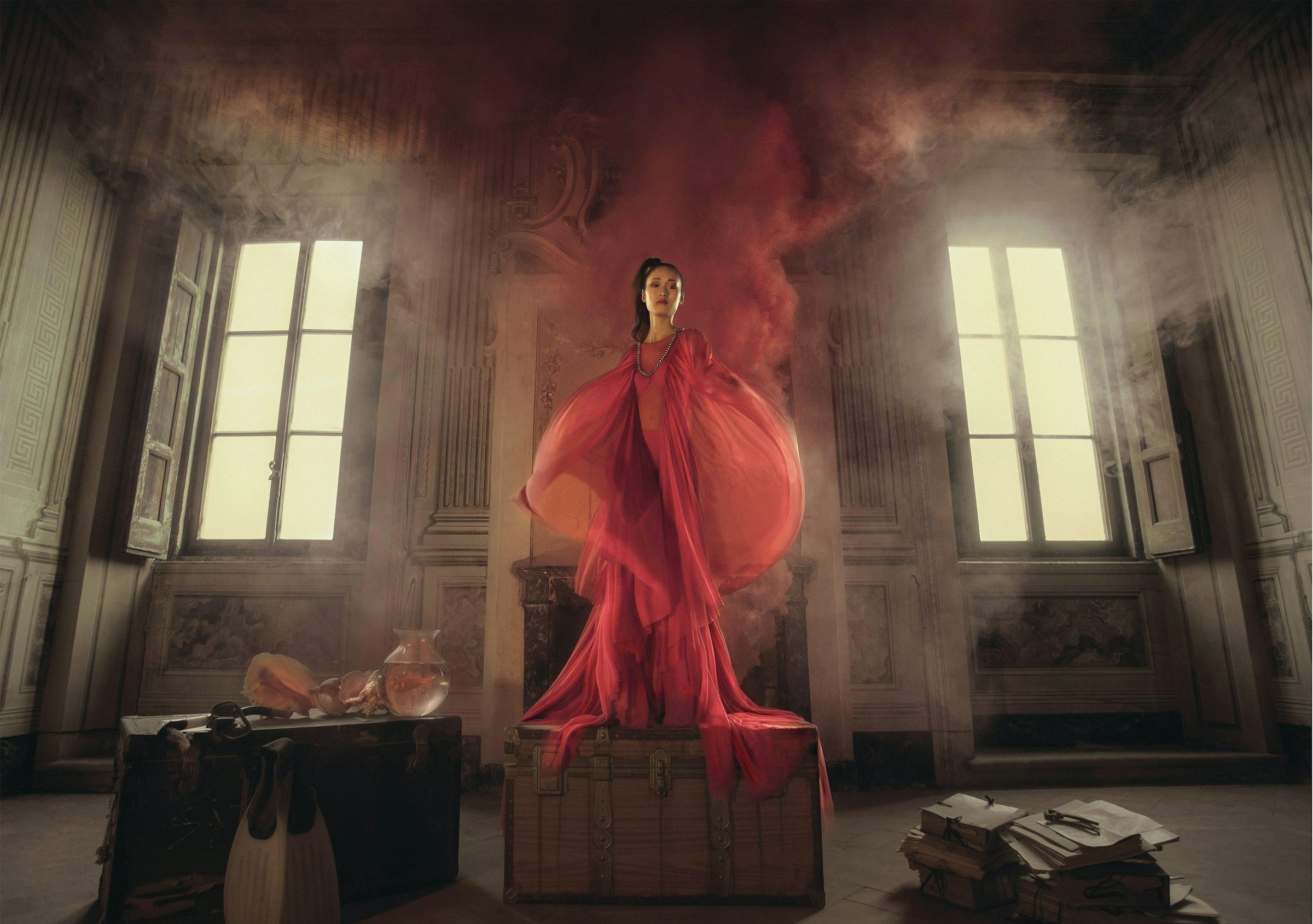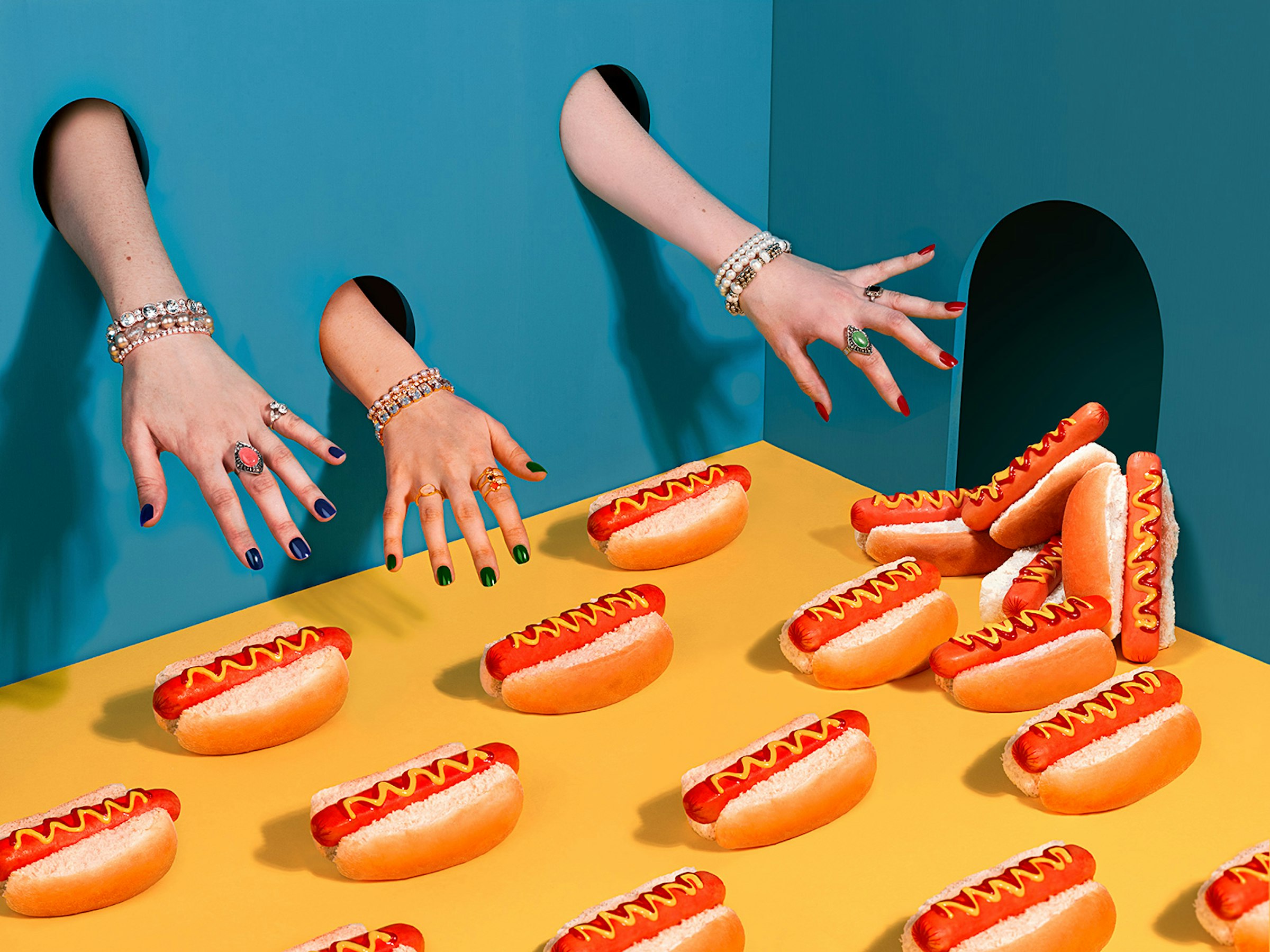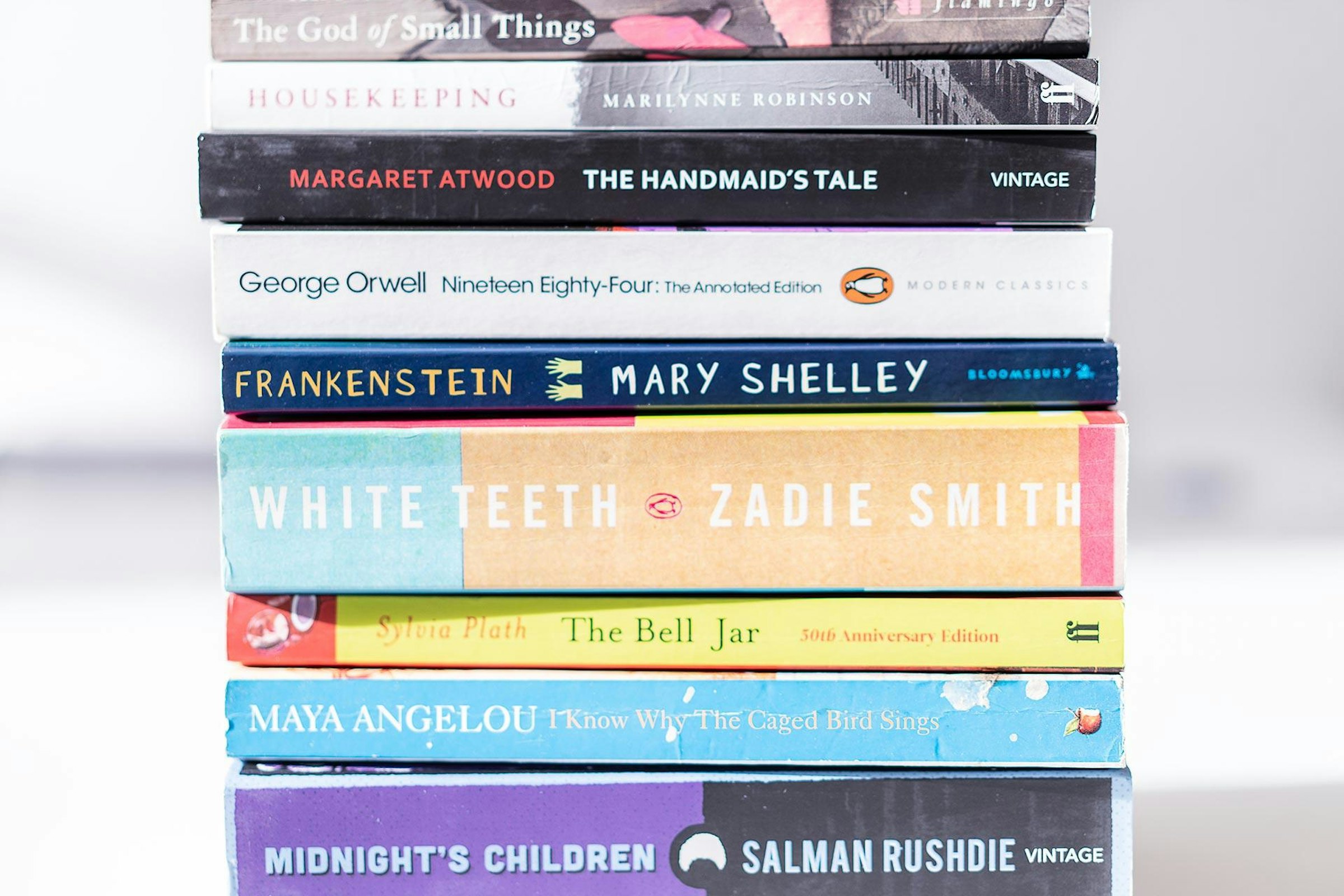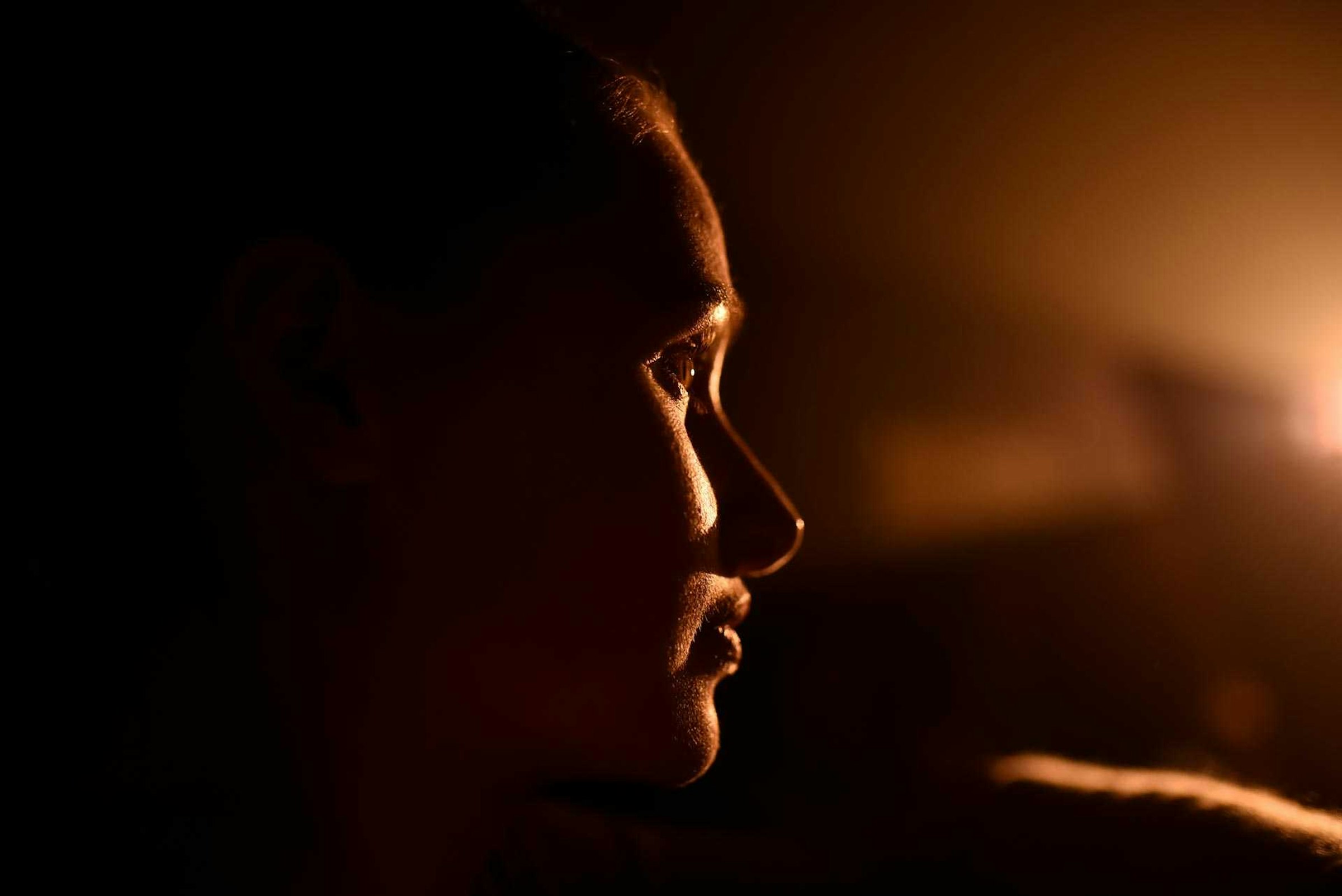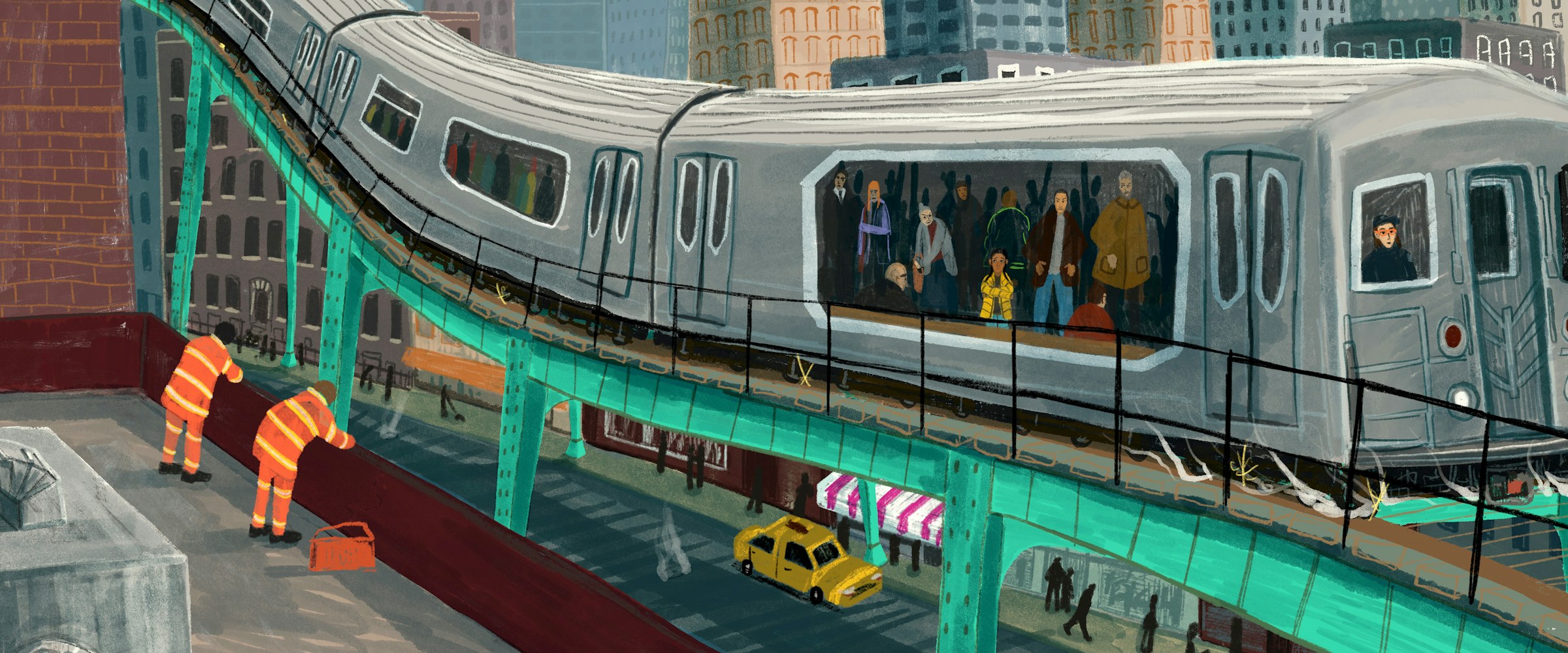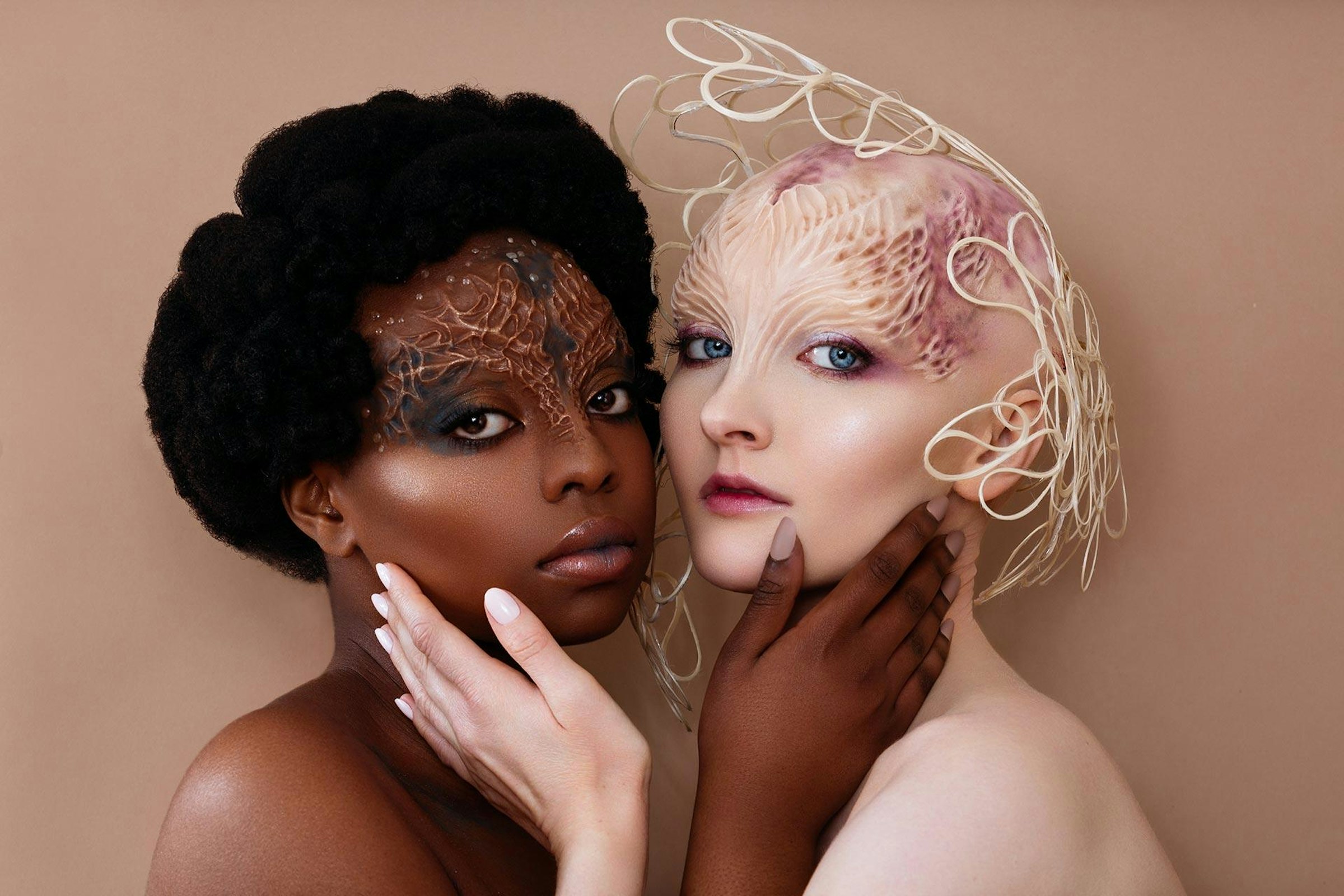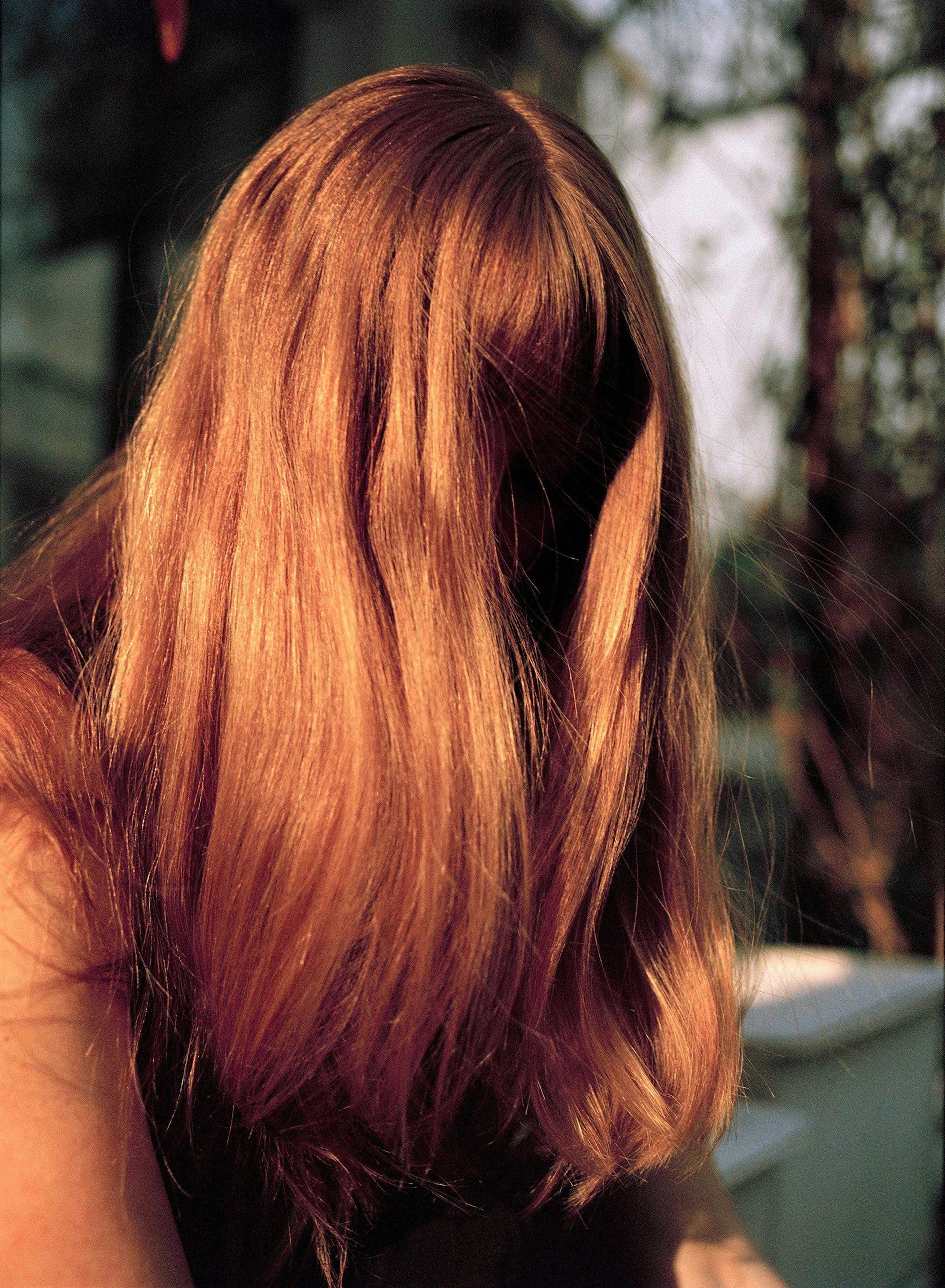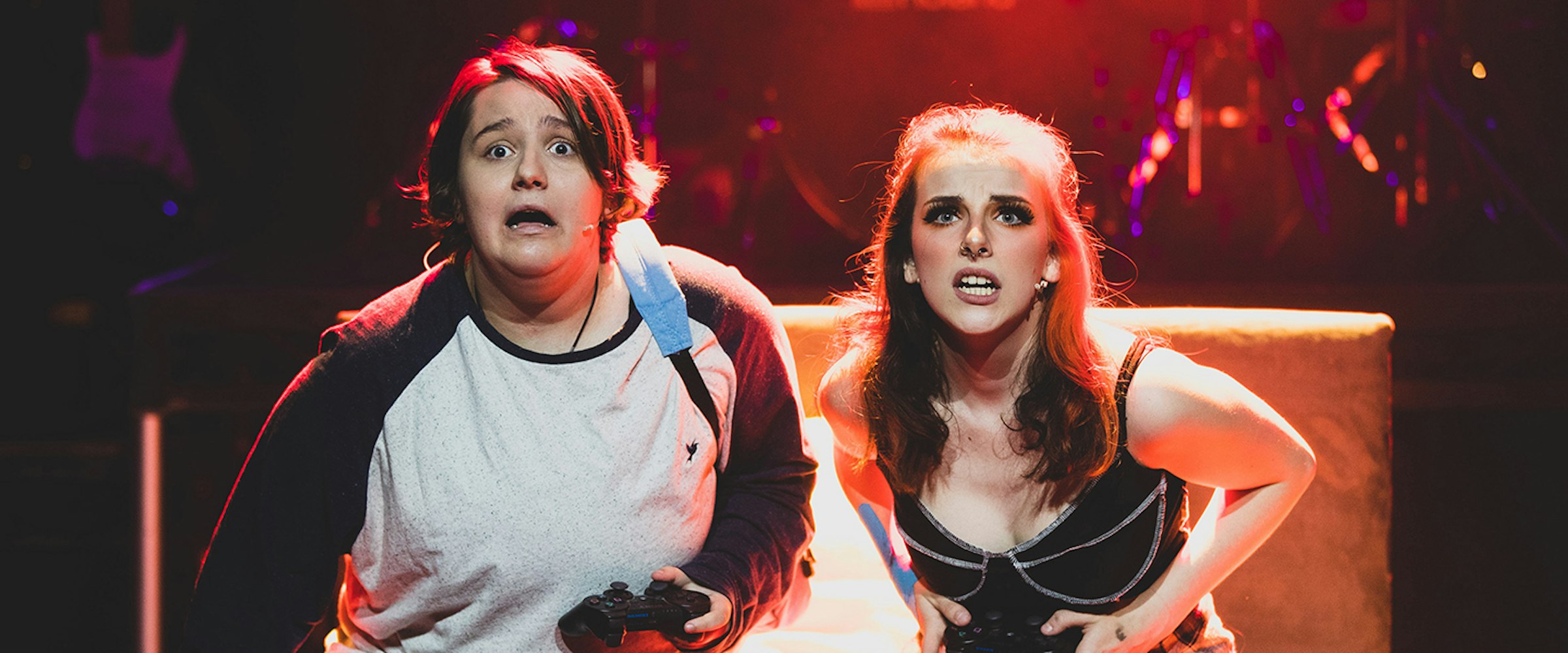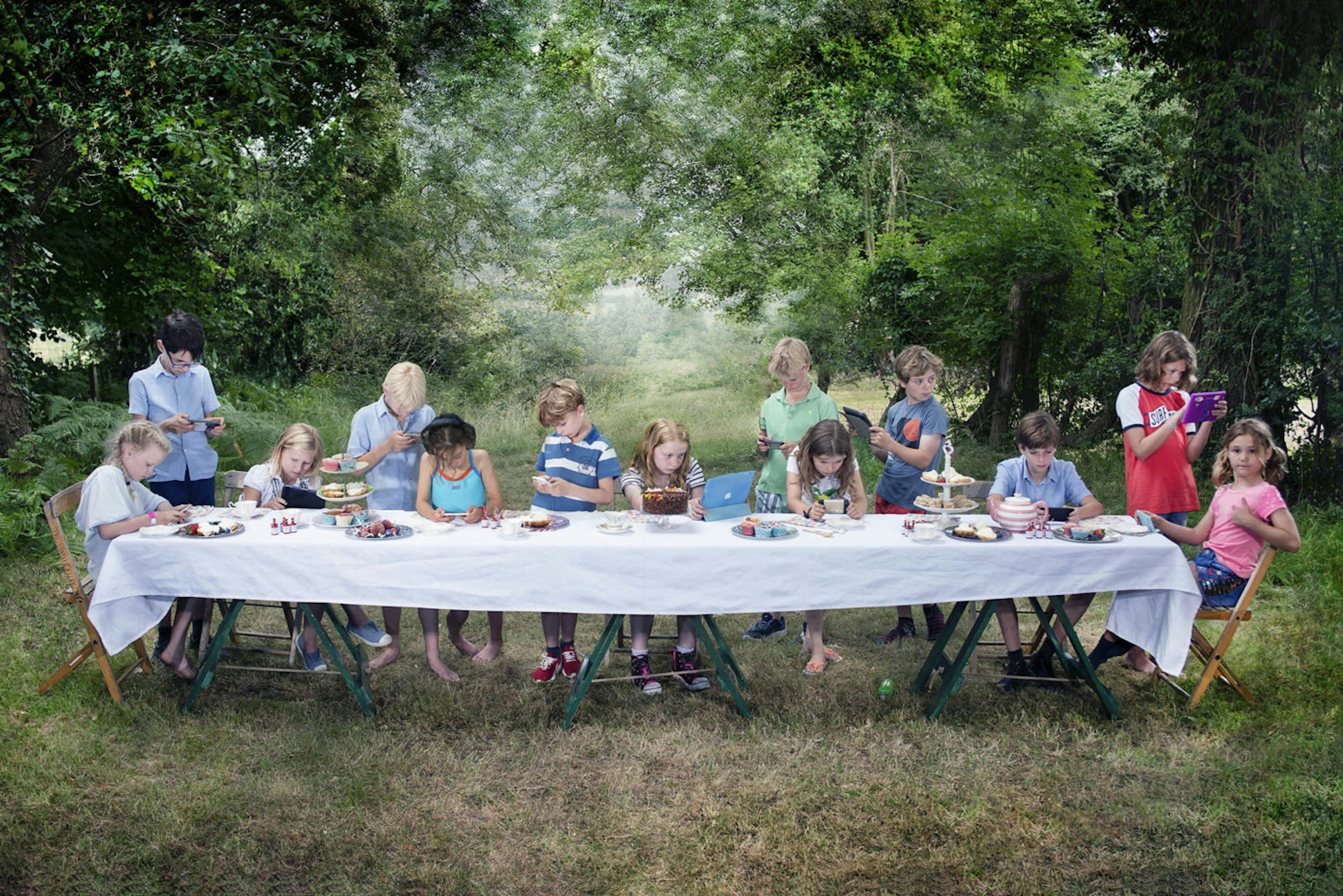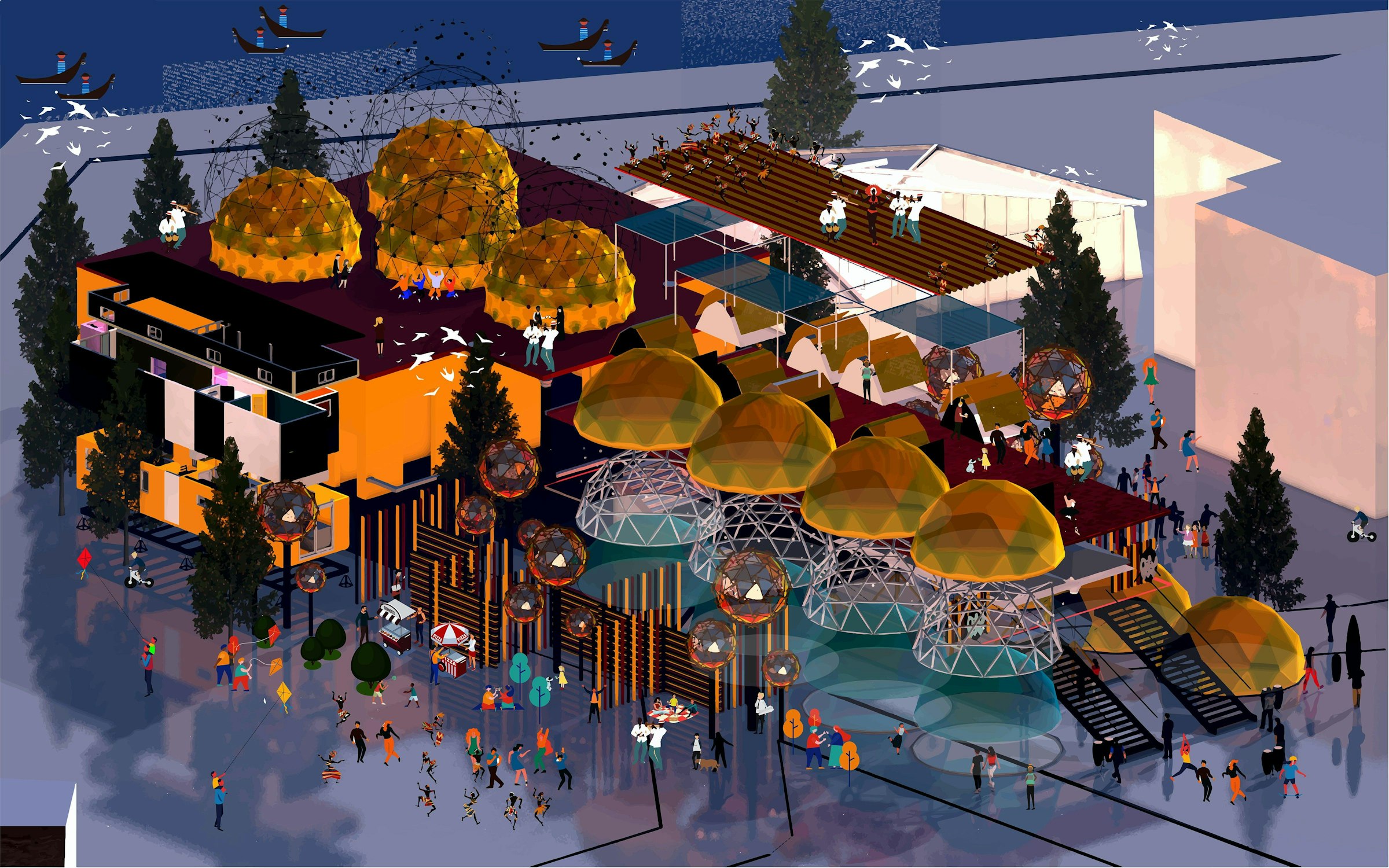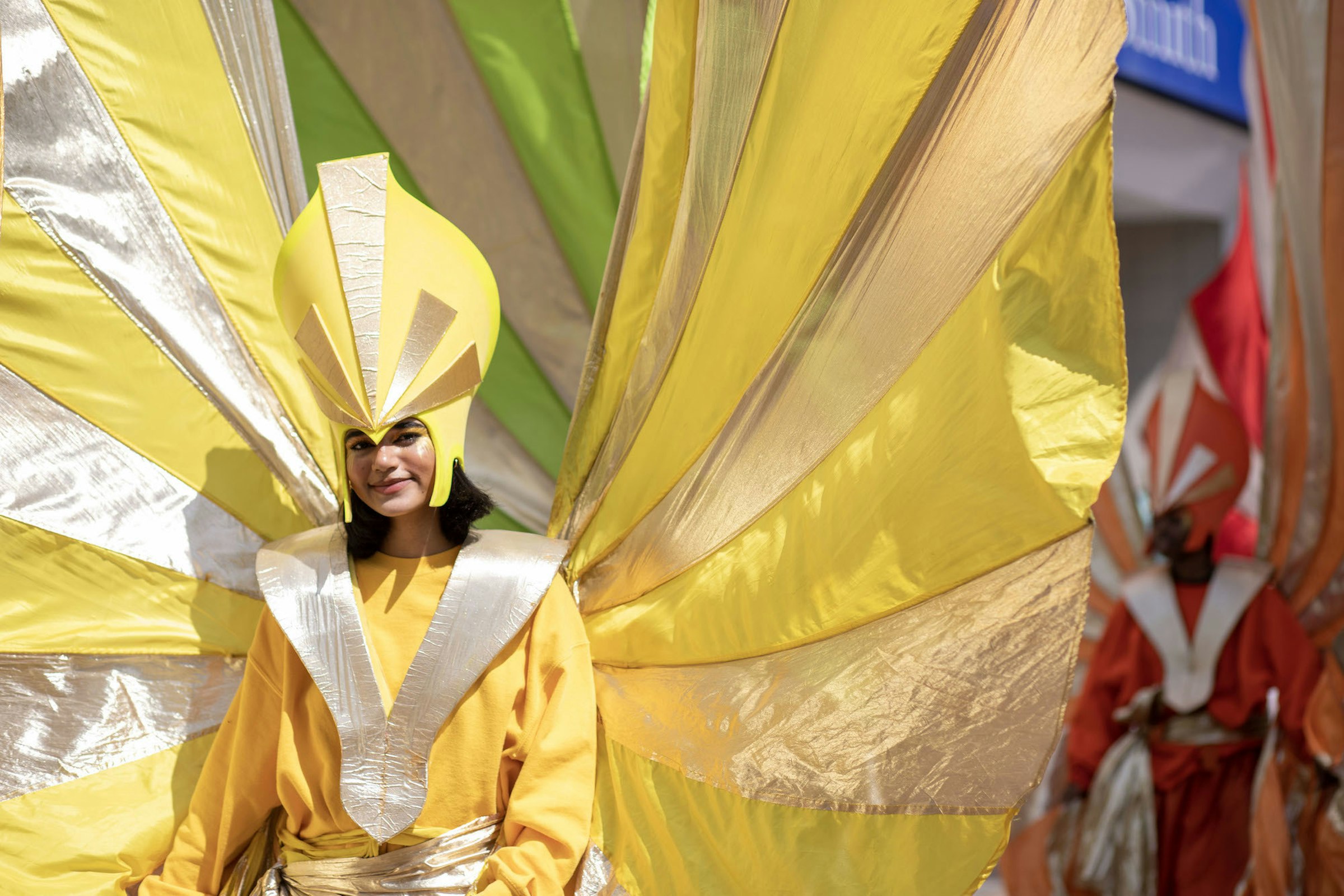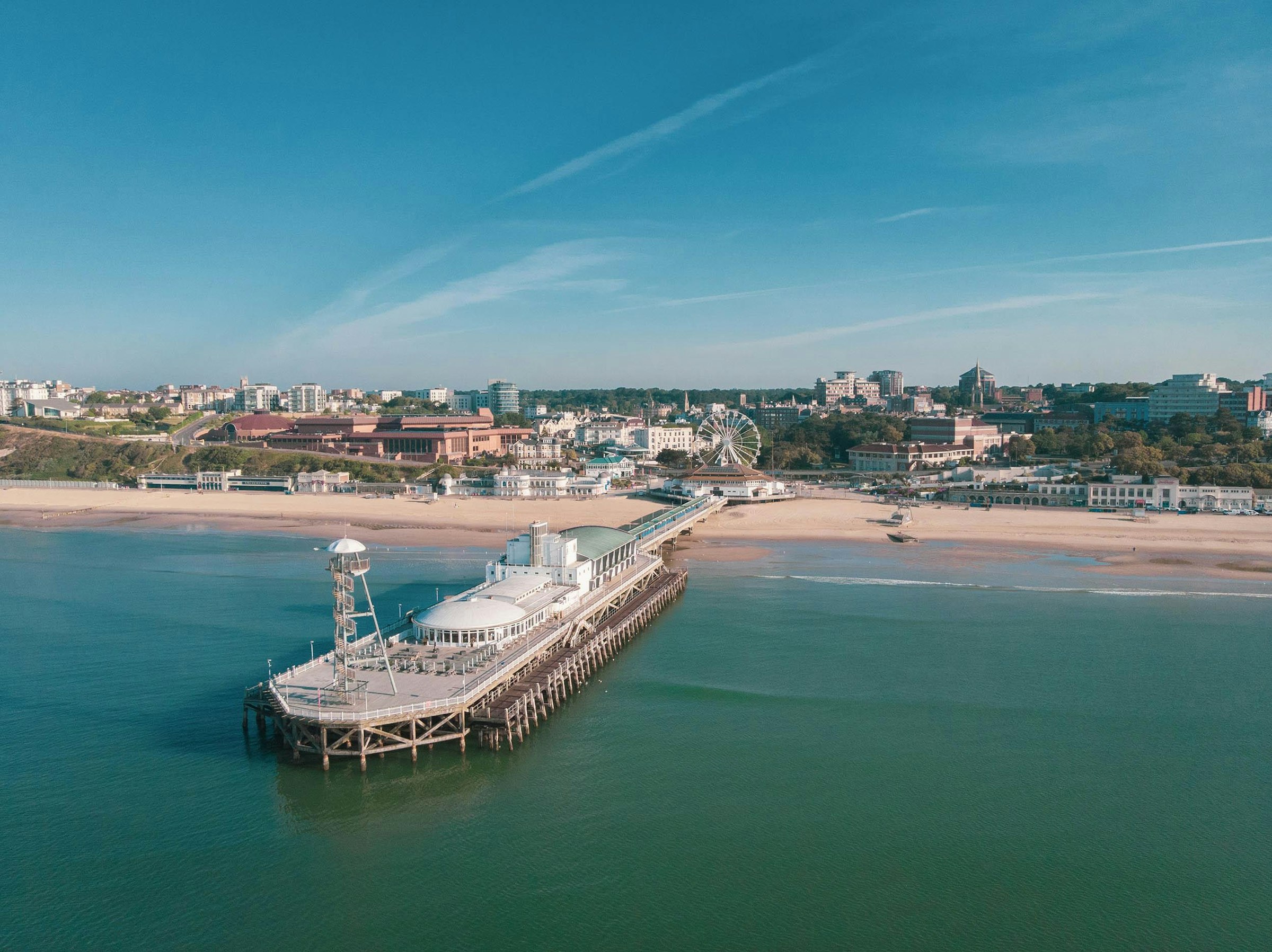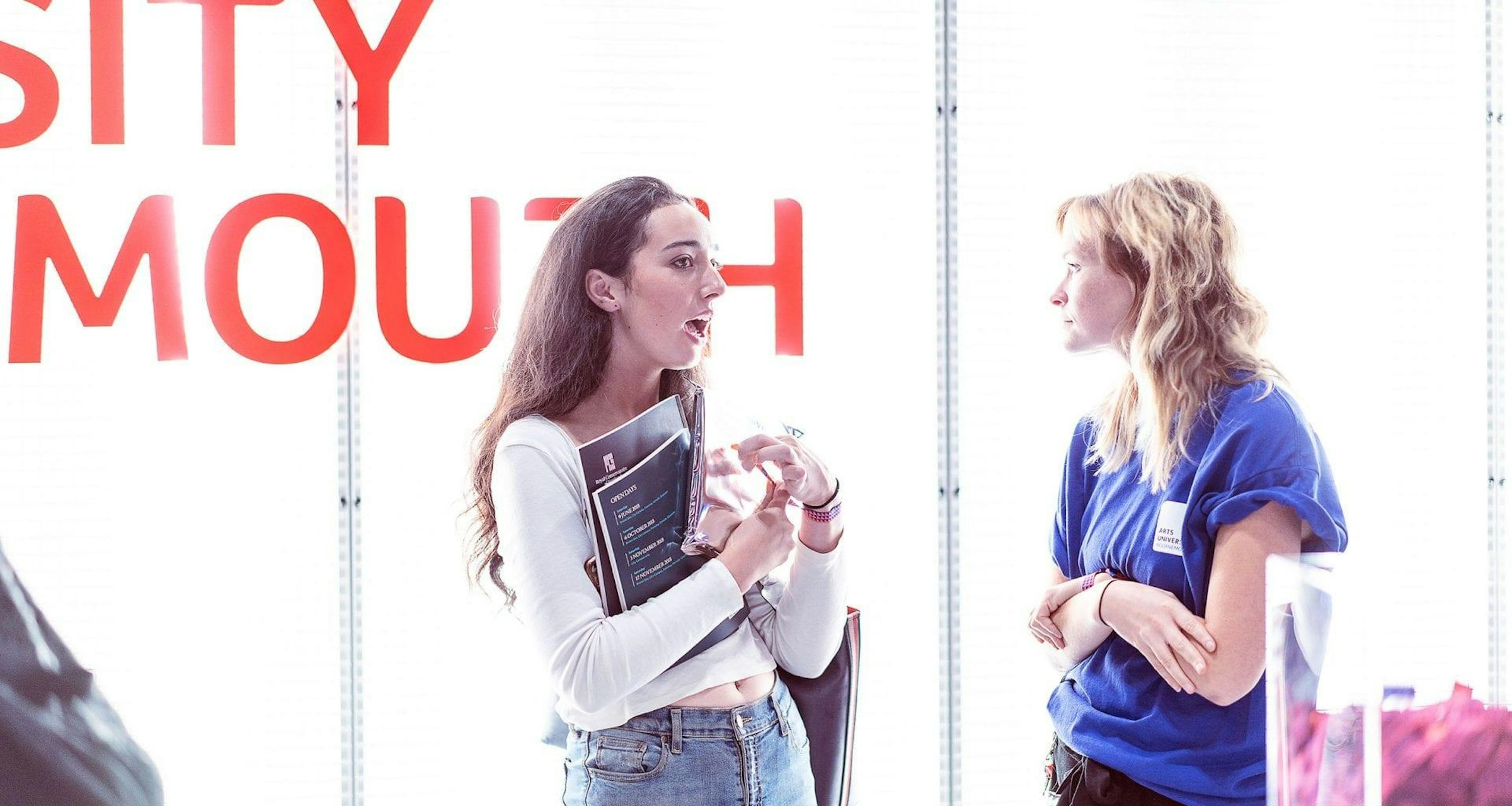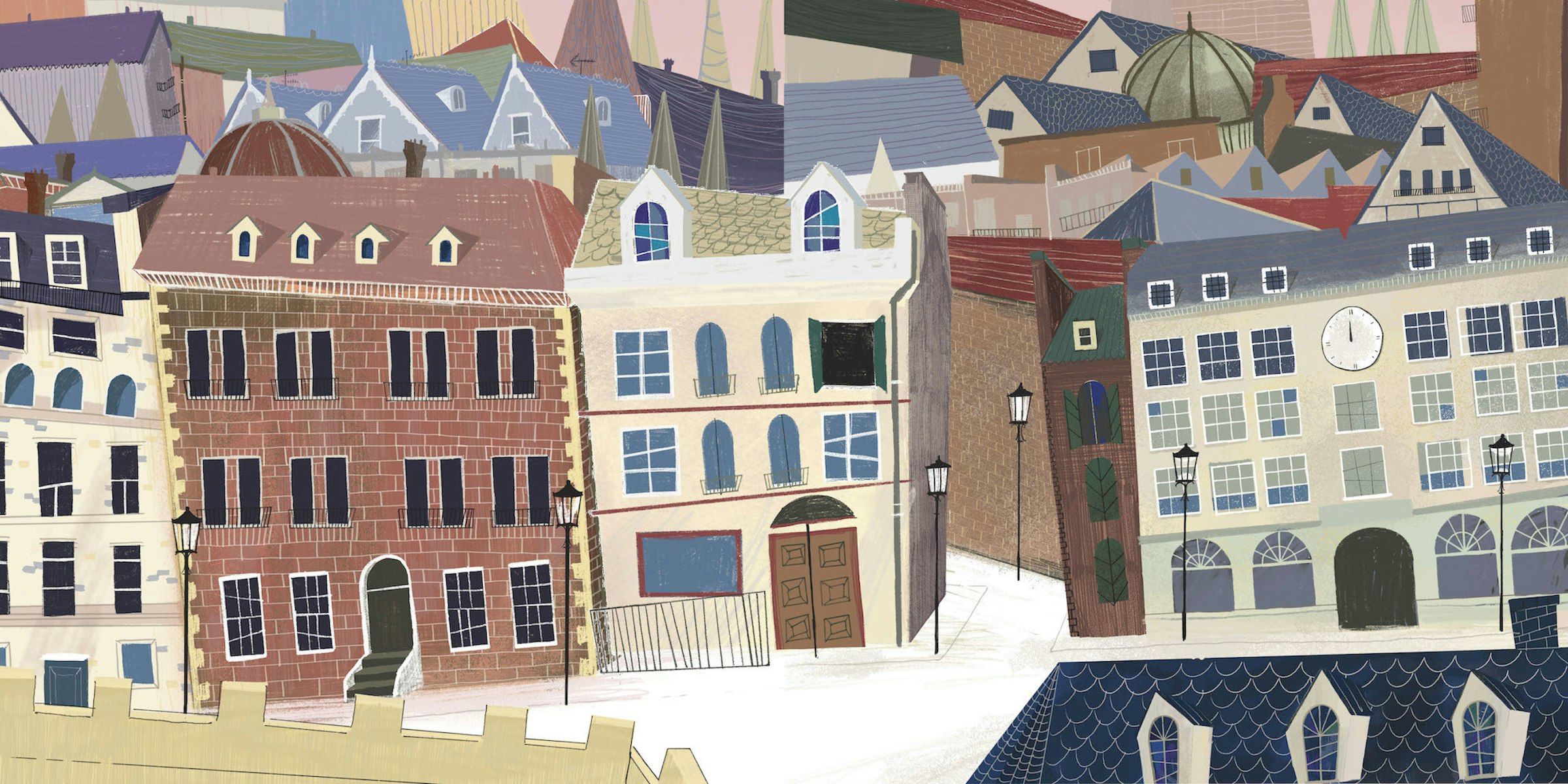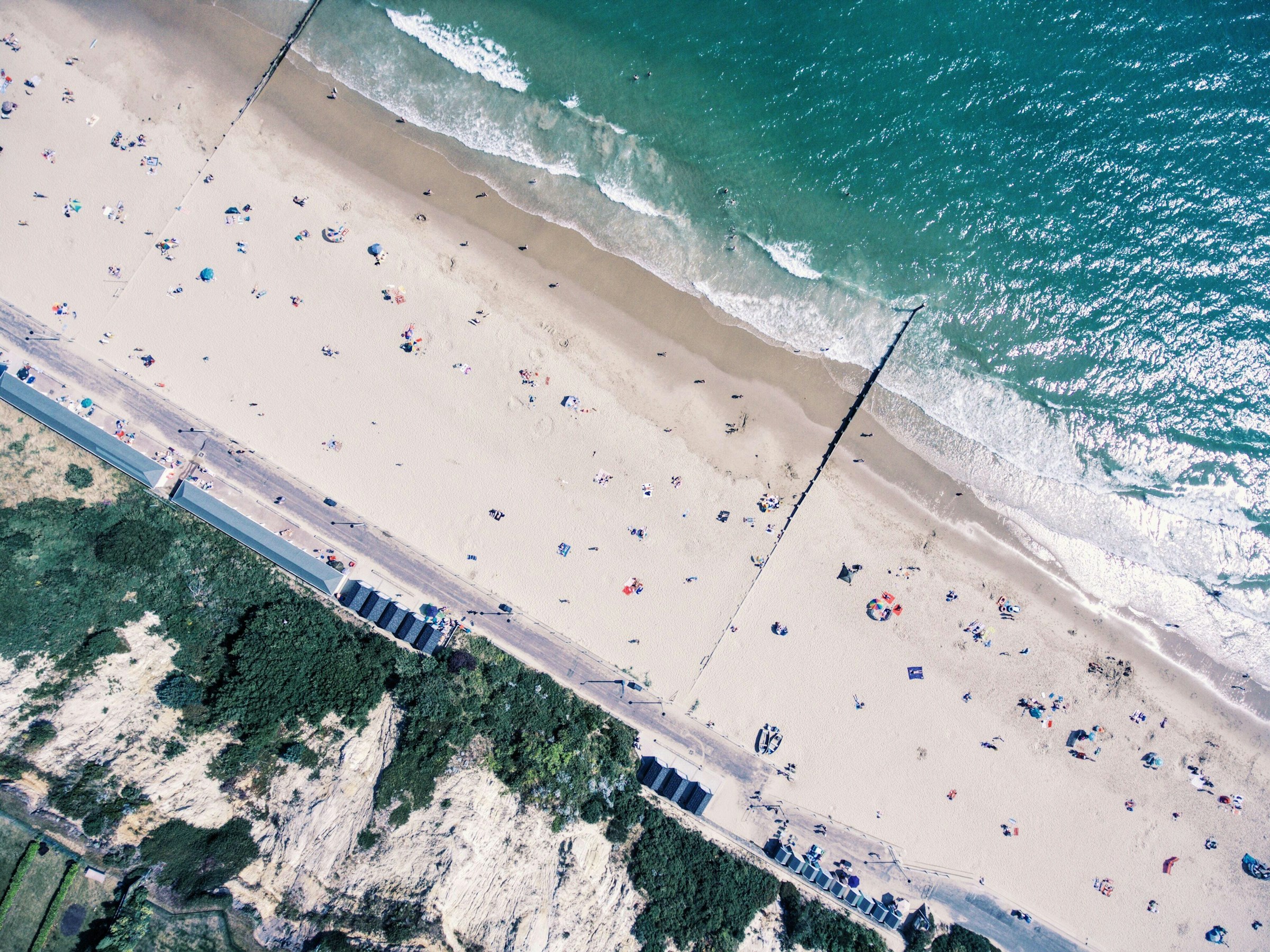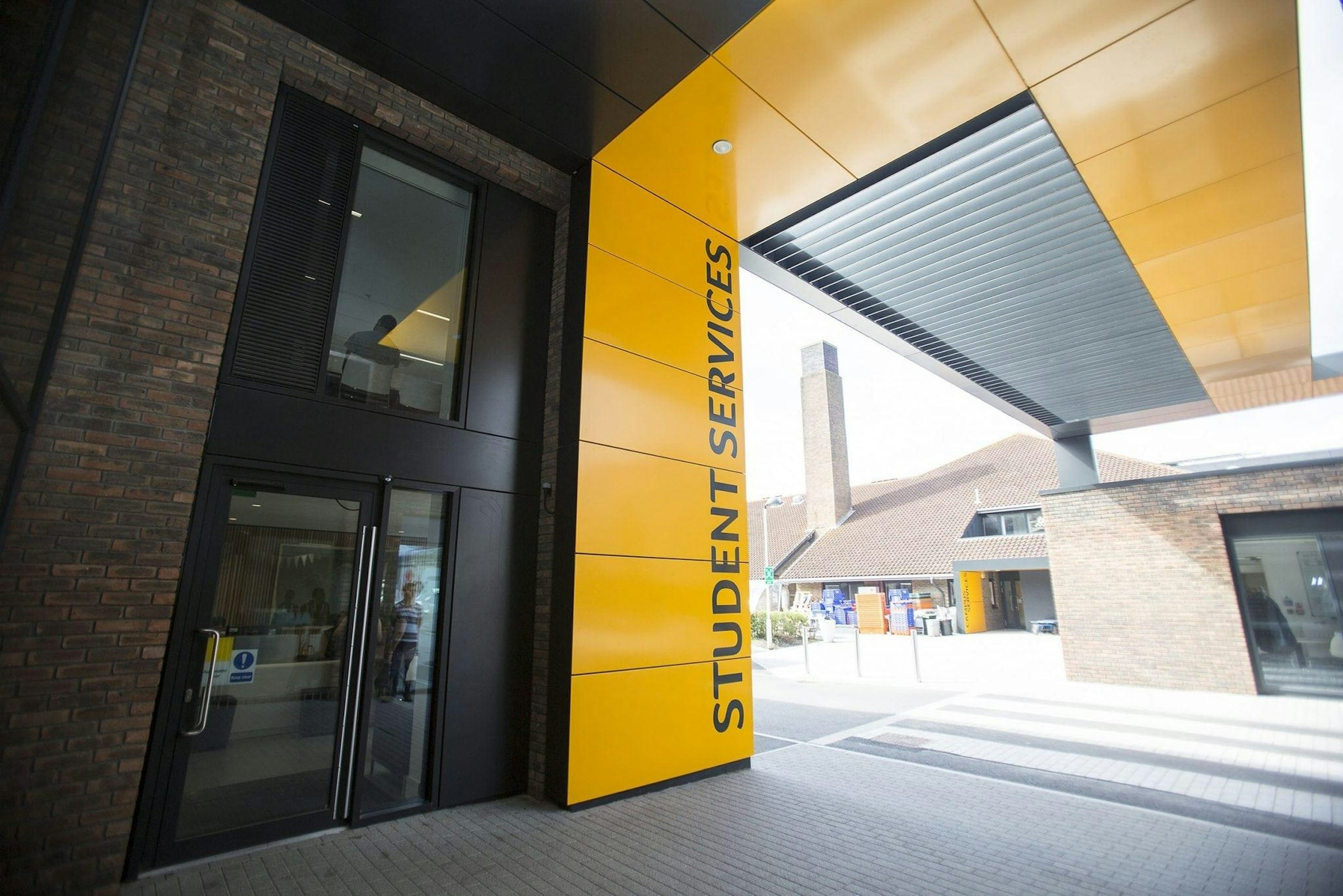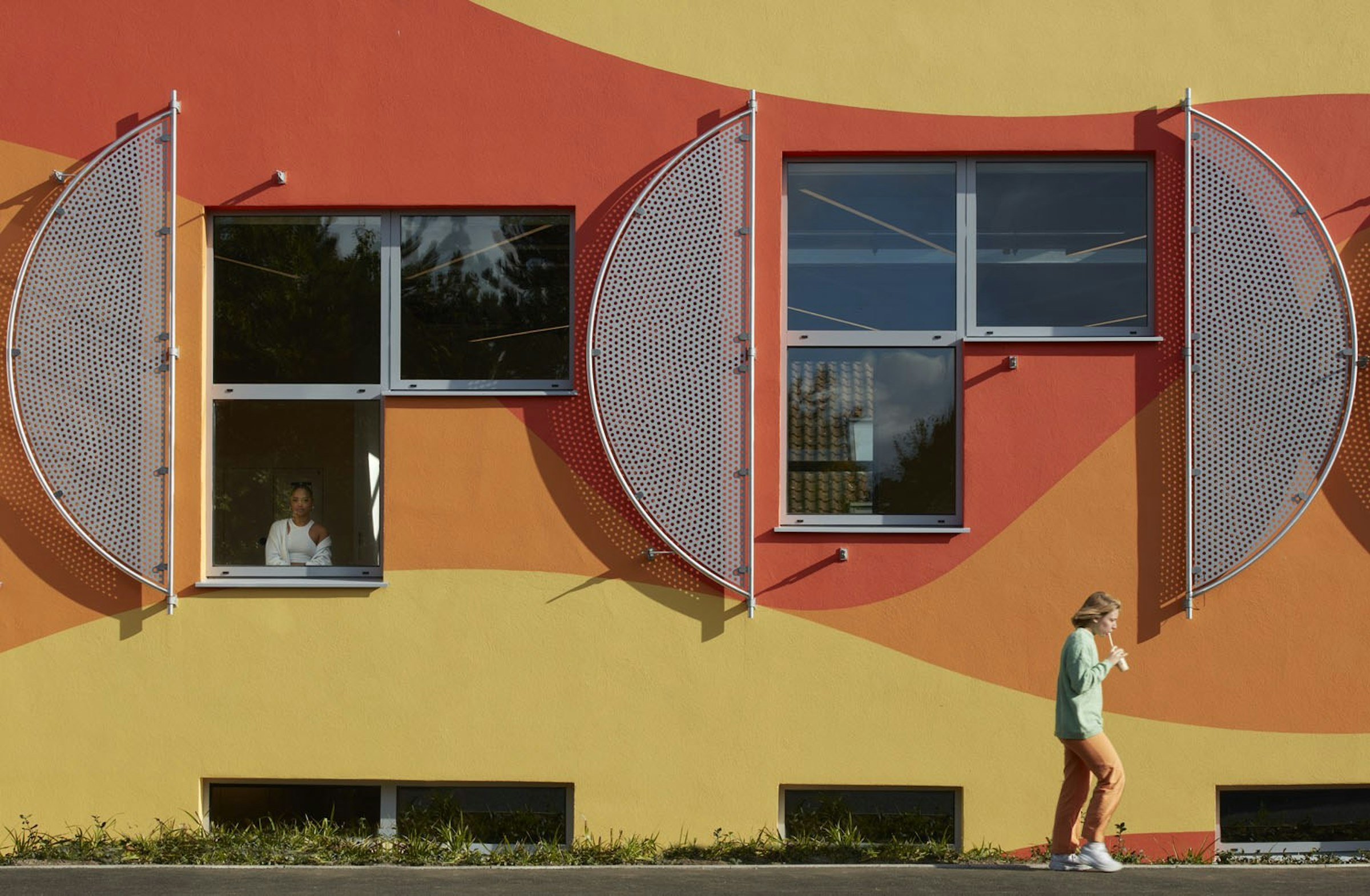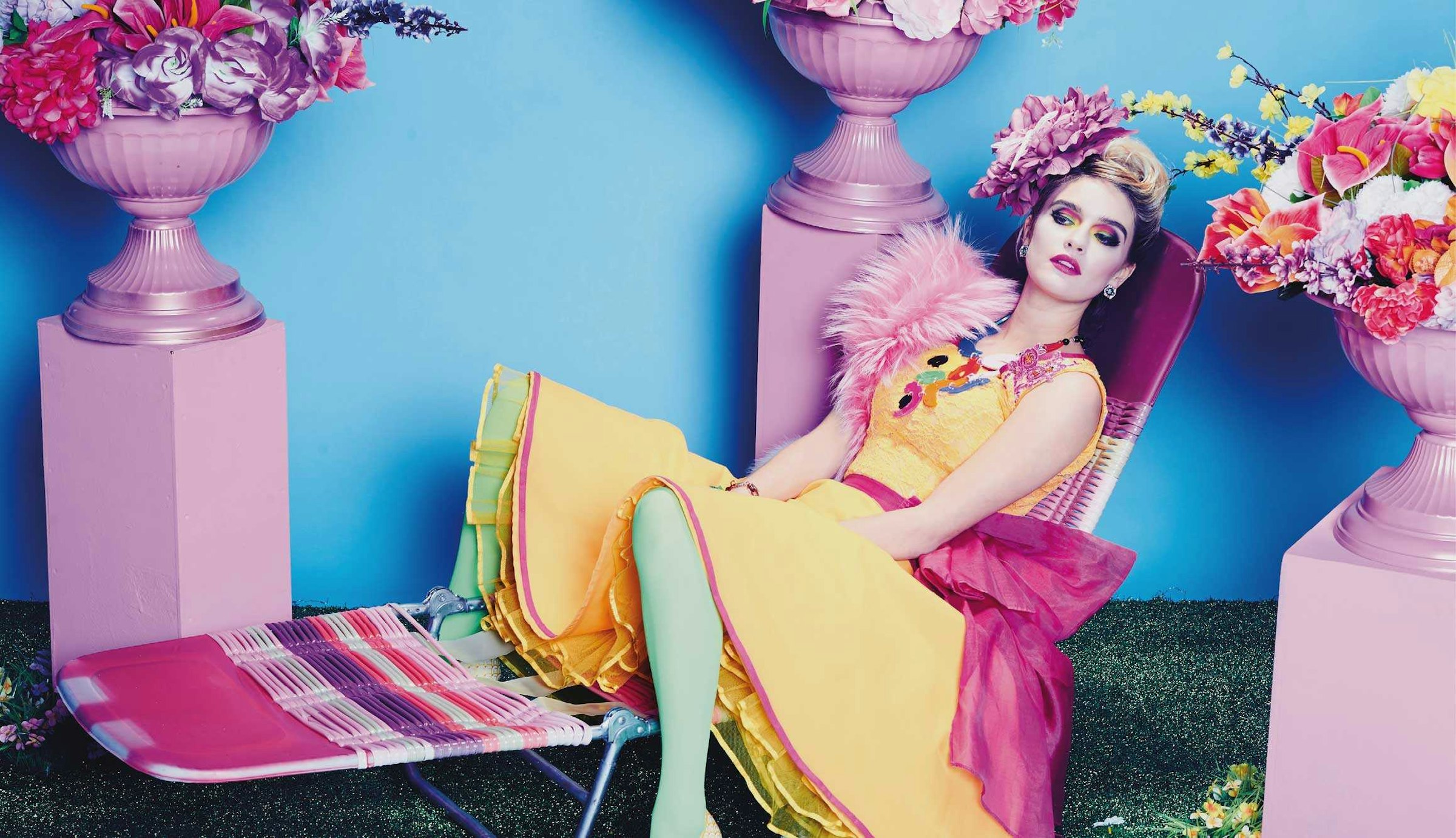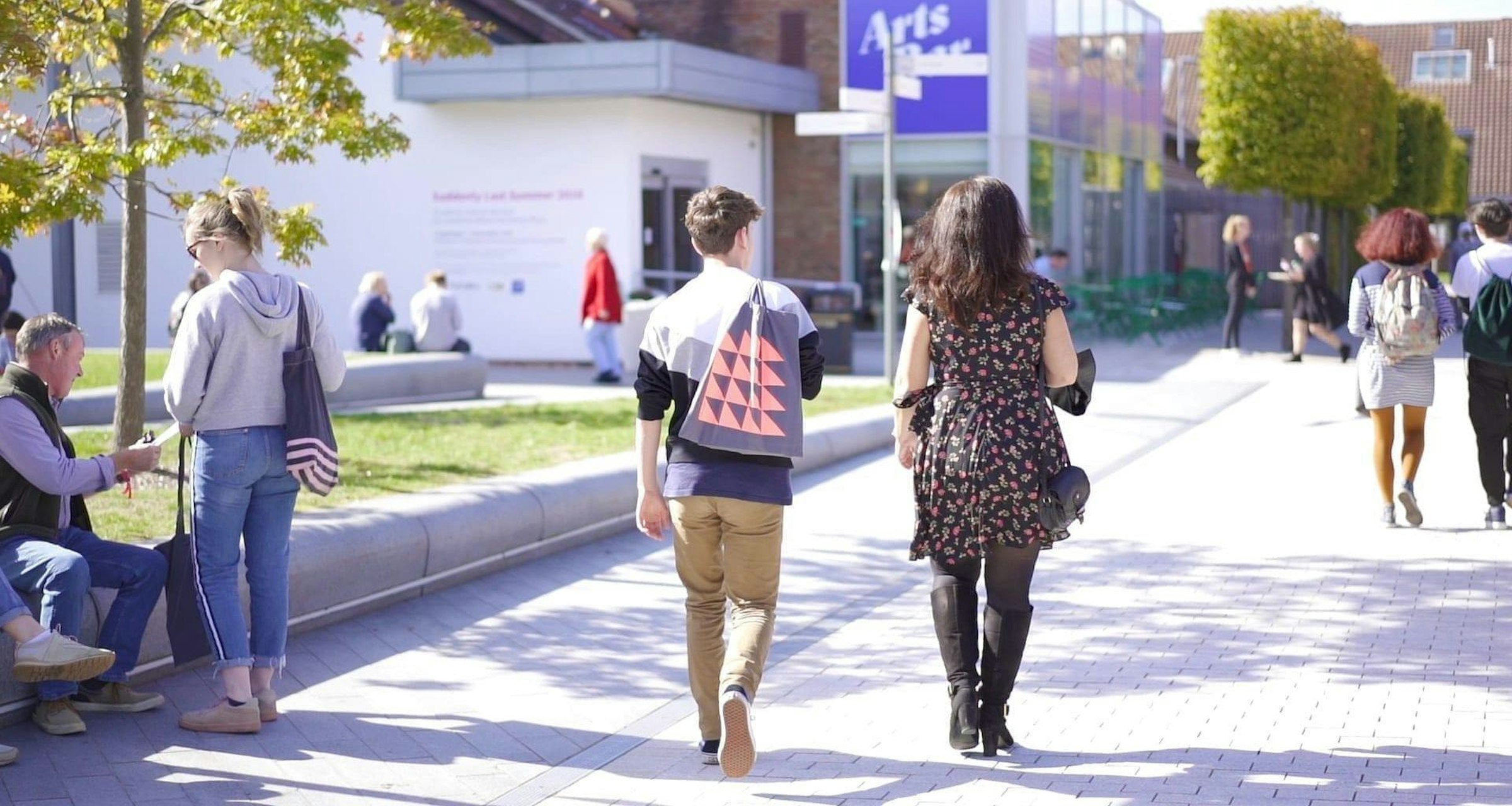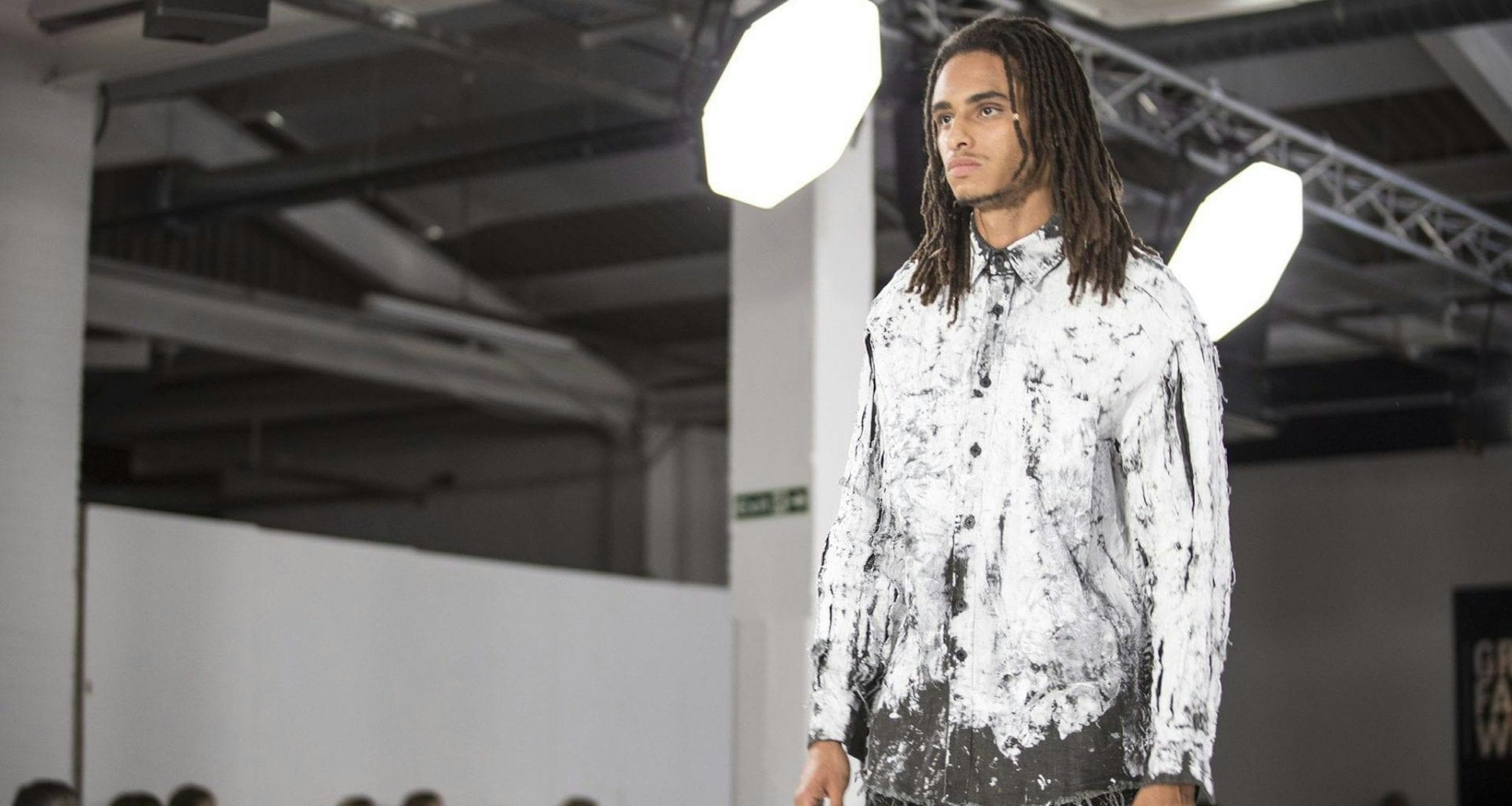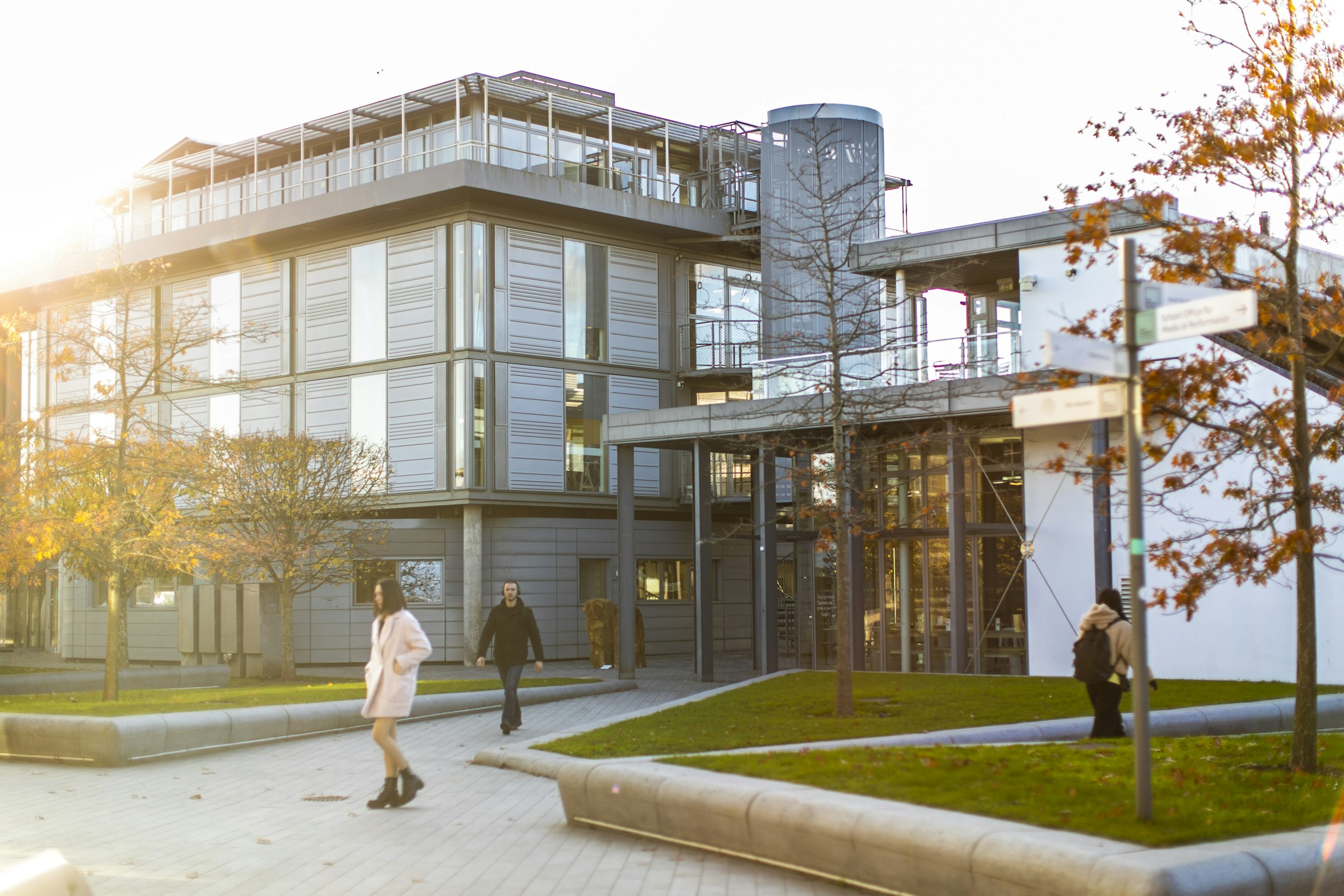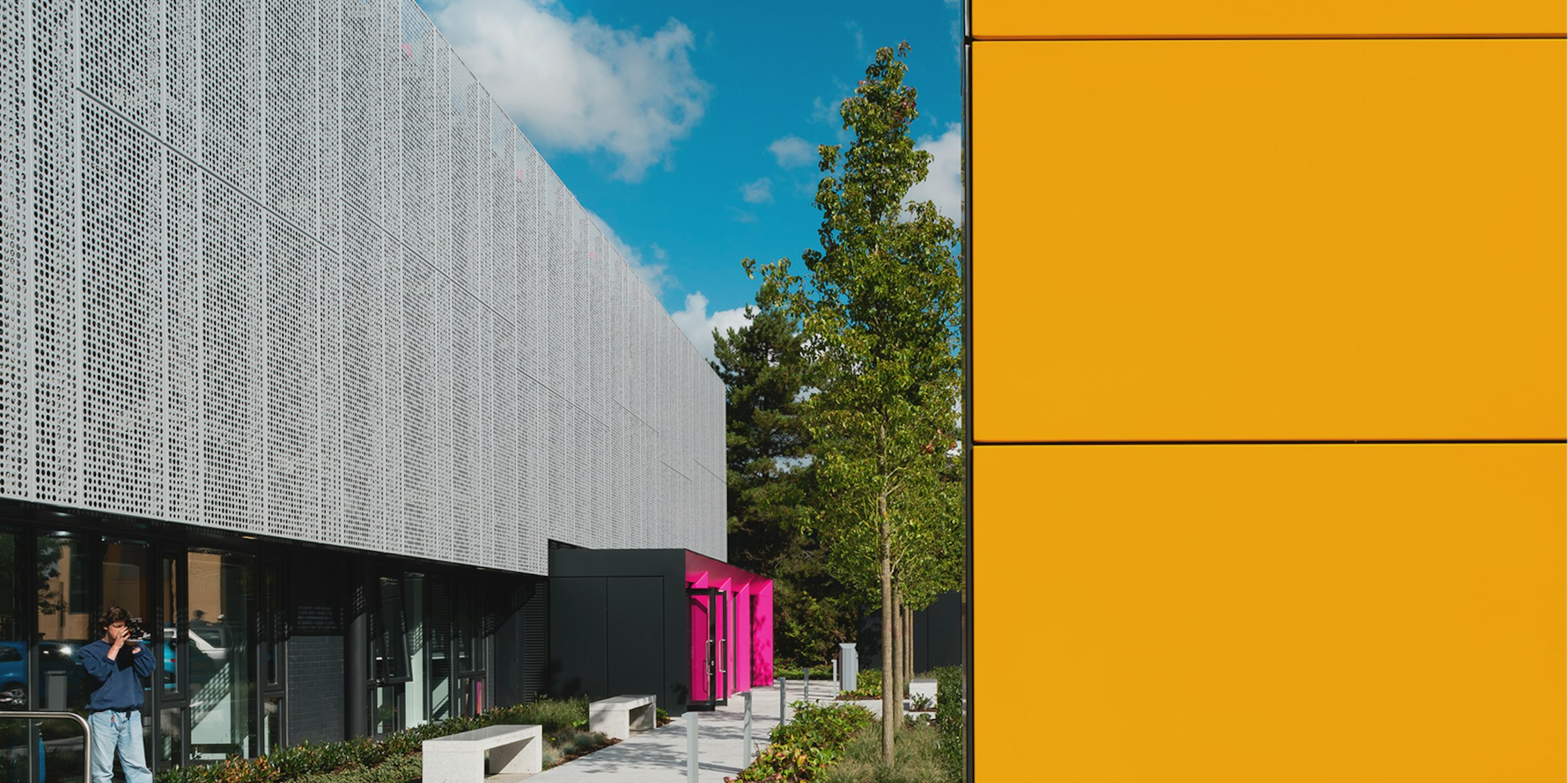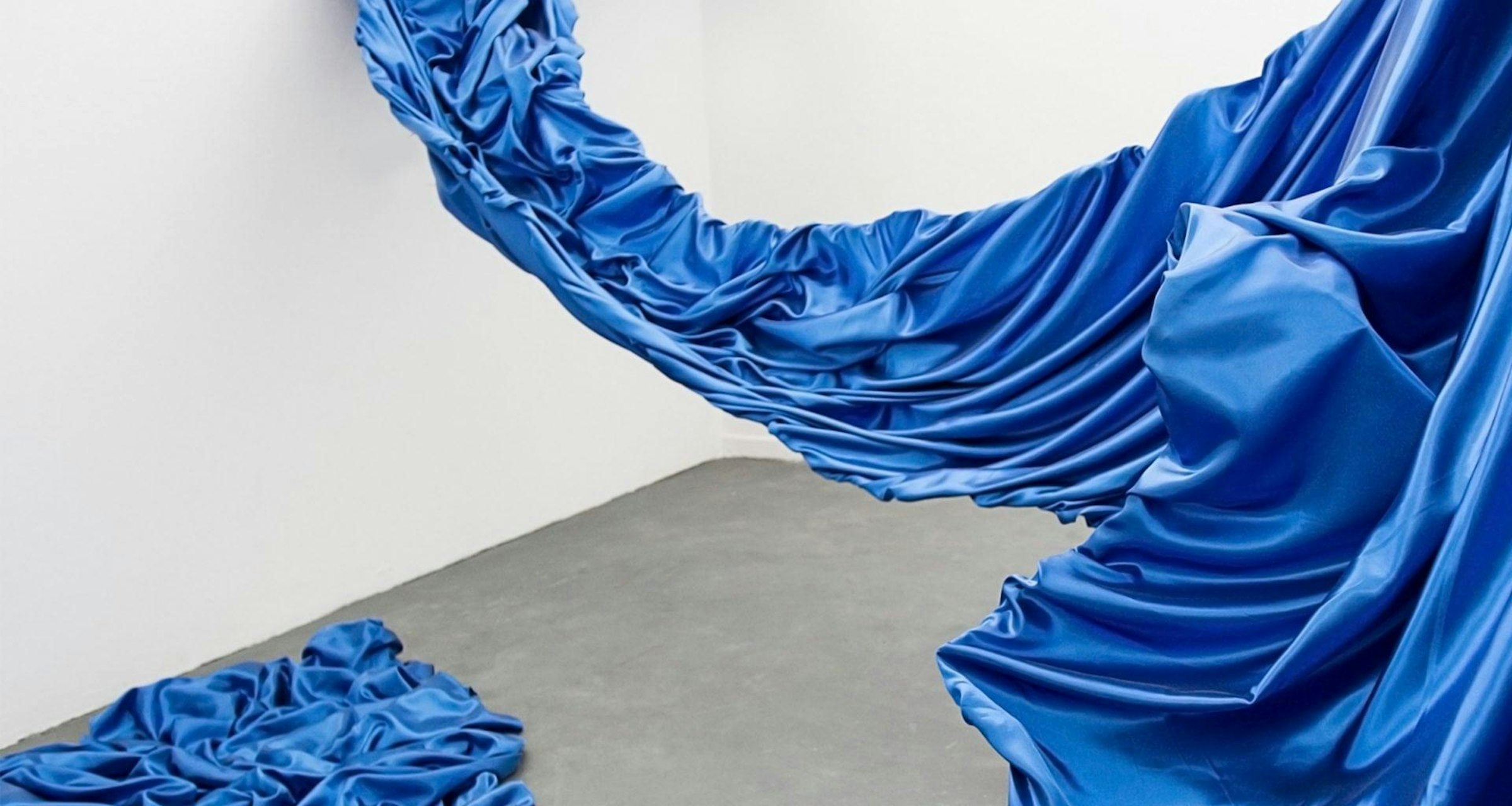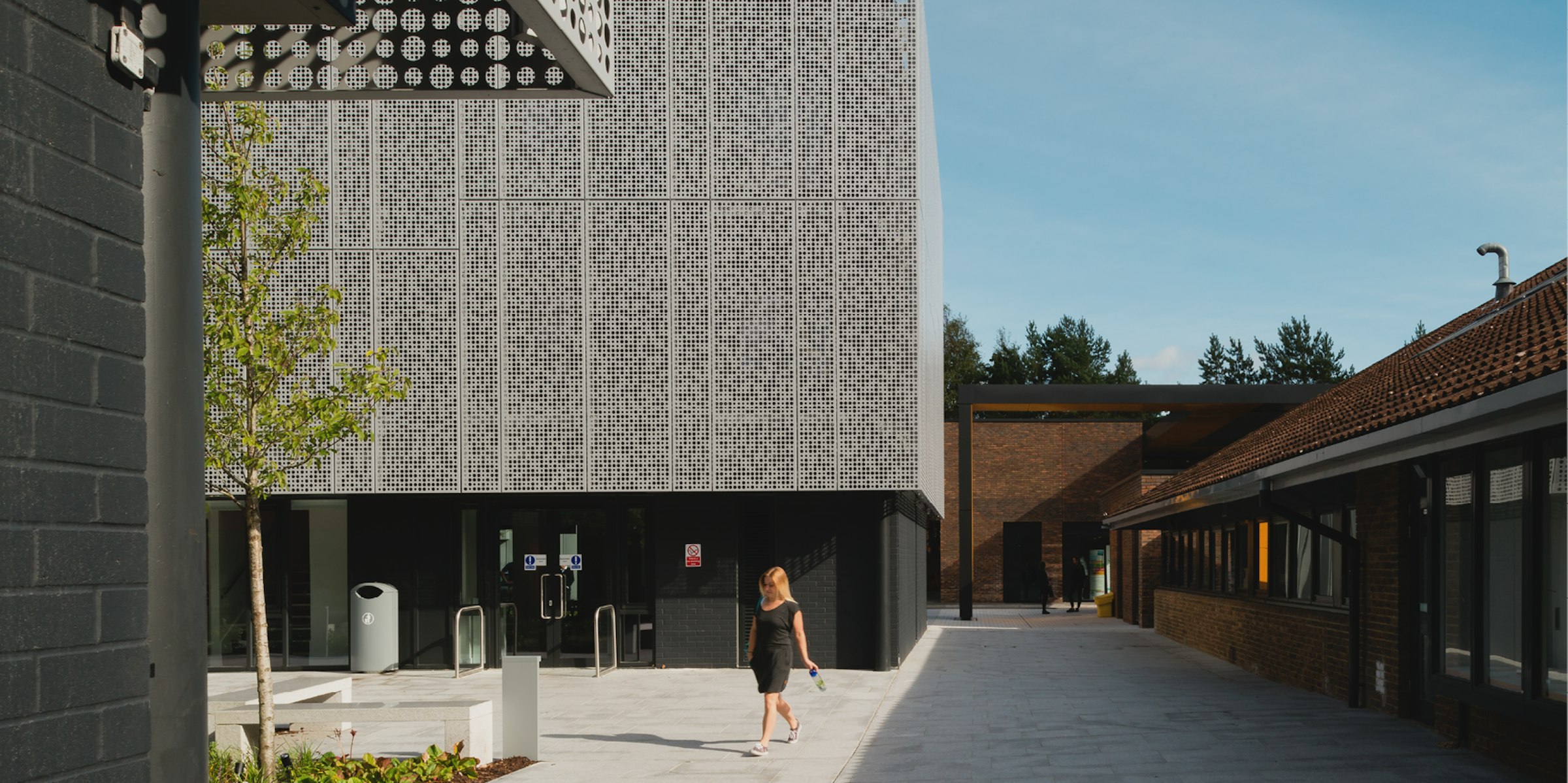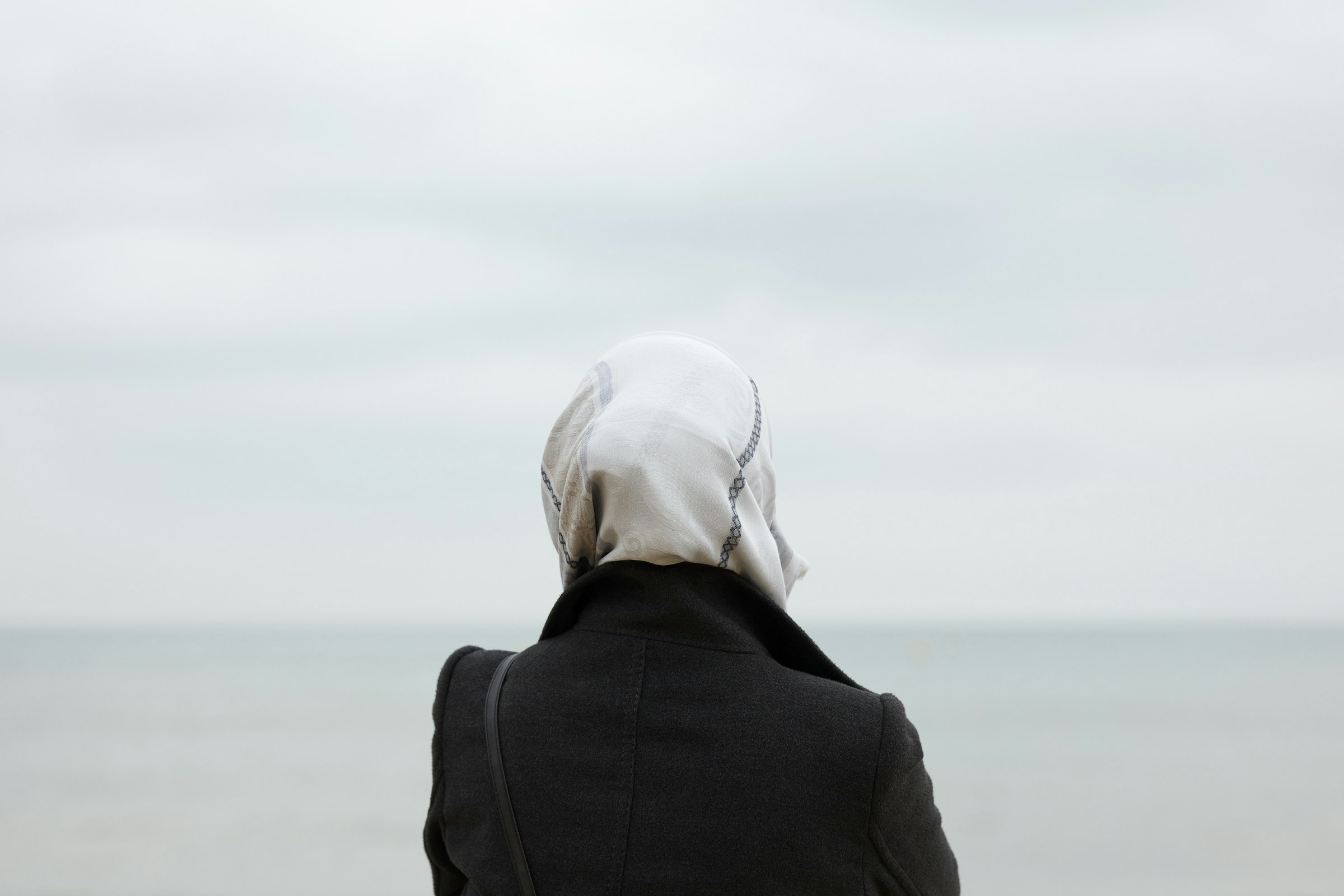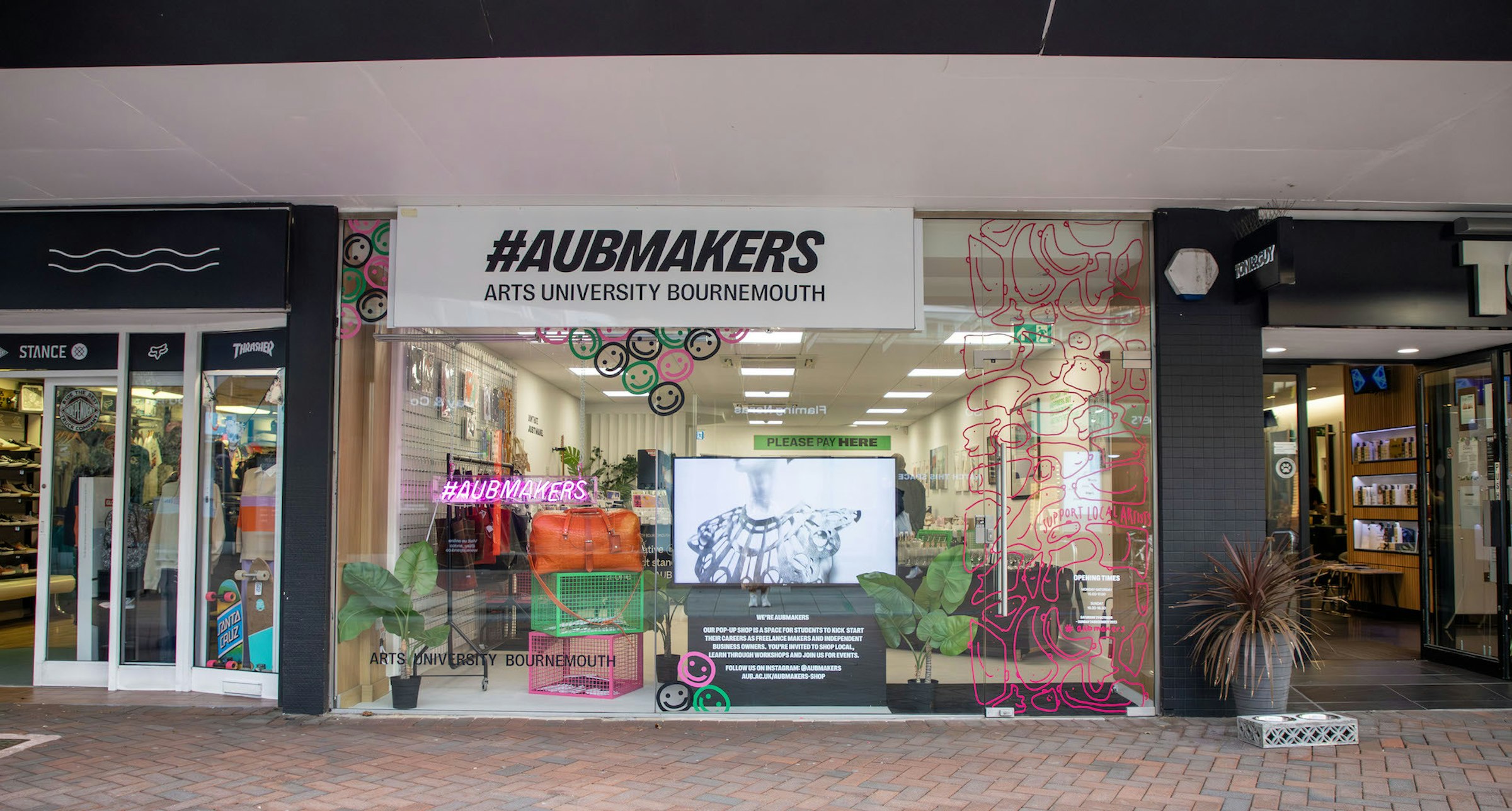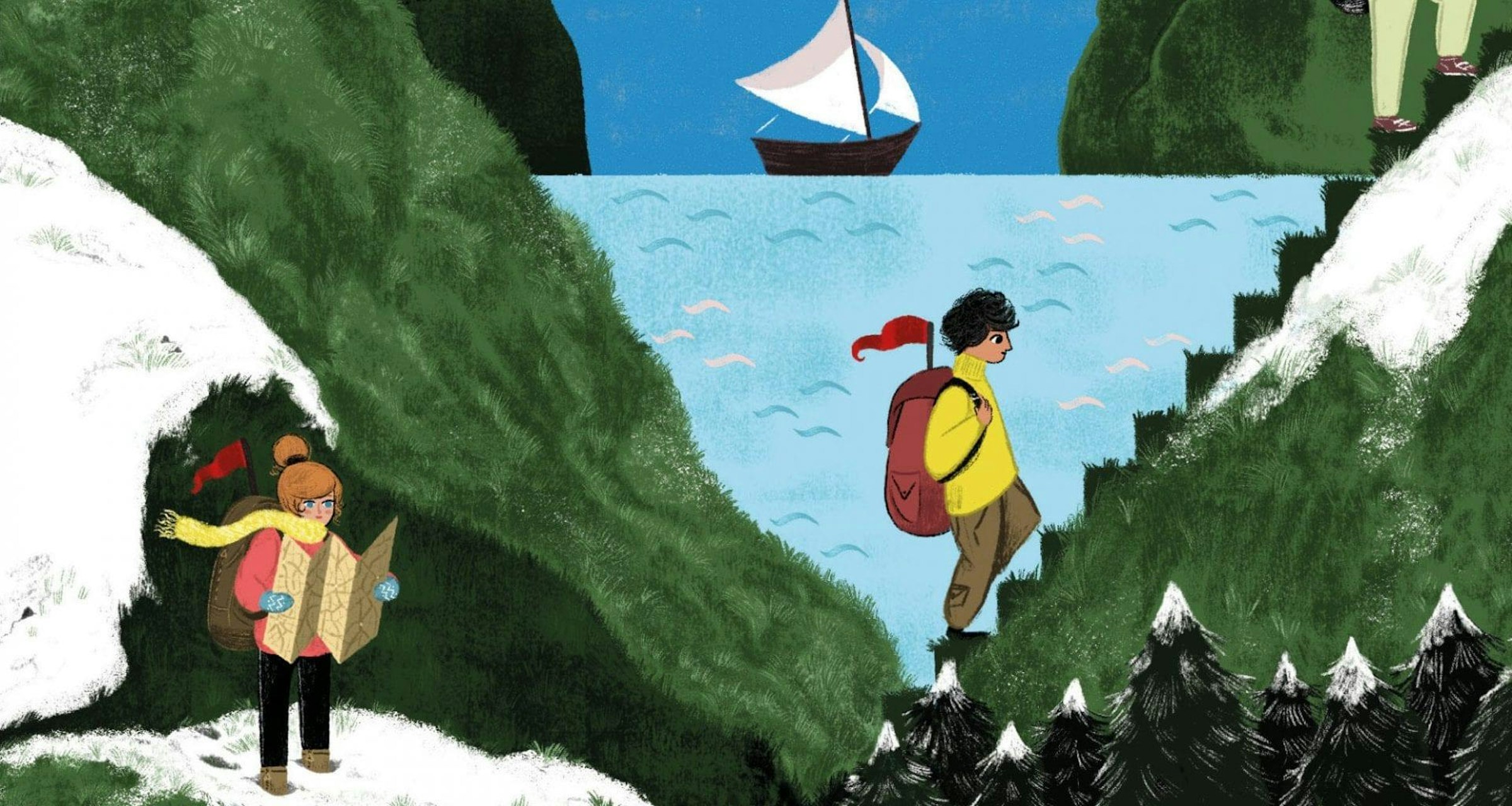
TheGallery at Arts University Bournemouth (AUB) in partnership with BA (Hons) Events Management, part of our new School of Arts, Media, and Creative Industries Management, presents The Art of Carnival Arts, an exhibition of work from Mahogany Carnival Design.
Exhibition overview
The Art of Carnival Arts is an exploration of Carnival’s history through the work of Clary Salandy and Mahogany Carnival Design.
Formed in 1989 by designer Clary Salandy and structural engineer Michael Ramdeen, Mahogany aims to heighten understanding of Carnival and Carnival Arts. The group of multidisciplinary artists have developed techniques of costume design and construction that utilise the human body in the art form of Mas Making.
Over the last 35 years, their large-scale kinetic costumes have made them a powerhouse within the world of Carnival, and they have brought majestic costumes to events both at home, such as the 2012 Olympics, and internationally, like the annual Trinidad Carnival.
Carnival arts have long been underrepresented and this will be one of the first exhibitions in the UK that elevates the art form by capturing Mahogany’s costume-making process from conception, to making, through to the costumes being worn in 2024’s Notting Hill Carnival.
The exhibition also tells the story of Carnival through its social context, presenting the audience with important historical milestones that transformed Carnival into how we see and know it today.
Meet the artist

Clary Salandy
Clary Salandy is a carnival and theatre designer, lecturer and three-dimensional design tutor. She's known for her award-winning...
Curatorial and exhibition design team
The creative team behind the curation, exhibition design and delivery of The Art of Carnival Arts: Mahogany Carnival Design includes:
Violet McClean | Kevin Chambers | Millie Lake | William Hernandez Abreu | Eliza Naden | Alicia Bermudez Garcia | Stephen Ramdeen
From Trinidad to Notting Hill: The History of Carnival
Prior to 1498
Before the arrival of Europeans, indigenous peoples of the Caribbean, such as the Arawaks and Caribs, celebrated festivals that honoured their deities and marked seasonal changes involving music, dance, and rituals.
Post-1498 – Arrival of the Spanish
In 1498, Christopher Columbus arrived in Trinidad, leading to Spanish colonisation and the gradual introduction of European festival traditions.
1783 – King Charles II of Spain issues the Cédula de Población
The Cédula de Población was a decree that encouraged Roman Catholic settlers, along with their enslaved Africans, to settle in Trinidad. They were offered 32 acres of land for each member of their family, plus 16 acres for each slave, meaning each settler sought to import as many slaves as possible.
Between 1783 and 1787, the slave population increased from 310 to 10,000. This largely French migration came from the northern West Indian. The planters established a French landed aristocracy and imported their traditions including ‘masquerade balls’ and fêtes champêtres (outdoor parties) to Trinidad.
Cane harvesting was a labour-intensive process involving forced marches of enslaved Africans from neighbouring plantations to more efficiently harvest the cane and participate in the cannes brulées or burning of cane fields. These controlled fires were designed to make harvesting more efficient and they became one of the few times of the year that enslaved Africans could gather in large groups together. They would be marched to the plantations with horns and shells blowing and slave drivers cracking their whips. The physically demanding and dangerous work became a ritualised part of harvesting activities where the enslaved Africans could express their cultural identity, often in ways that mocked or challenged the colonial system.
1785 – Carnival traditions established in Trinidad
Carnival season lasted from Christmas to Ash Wednesday and Roman Catholic Mardi Gras style festivities were celebrated by the ruling white French diaspora, including masquerade balls, dancing and music. Celebrations culminated in Carnival festivities over the three days prior to Ash Wednesday, starting on the Sunday.
Many slave owners began masquerading as slaves, parodying African cultural traditions. A popular masquerade included dressing as field slaves (negue jardin) and parading with torches and drums inspired by the cannes brulées. The white ruling class would wear black masks and perform African dances such as the Ghouba, Bélé and Bamboula and engage in Calinda stick fighting rituals.
1789 – Governor of Trinidad decrees that all Africans will observe Roman Catholic religion and holy days
French influence and Roman Catholicism dominated in Trinidad, despite the government being British. Although enslaved Africans were excluded from participating in many festivities, including Carnival, they were allowed certain freedoms at Christmas.
Authorities feared that these freedoms could lead to insurrections. Martial law was declared, and all freemen aged between 15 and 55 were required to enlist in a militia over Christmas and New Year. Although the militia laws were suspended in 1846, the militia drills continued until the late nineteenth century and became a spectacle of uniform wearing and parading.
Meanwhile, the enslaved population celebrated Christmas and preserved their cultural traditions with dancing, drumming, chac-chac playing (a kind of rattle) and the wearing of costumes which often imitated those of their slave masters. Over time, they organised their own mock militia regiments including Kings and Queens and other official roles with flags and uniforms. These military masquerades continued well into the 20th century.
1797 – Trinidad becomes part of the British Empire
British forces captured Trinidad from Spain during the Napoleonic Wars, and it became a British colony. Slavery continued under British rule and the slave population more than doubled over the next 25 years. Carnival activities were often seen as anti-establishment by the British colonial authorities and, within two months, a British law was passed stating that the non-white population required police permission to hold dances or entertainment after 20.00.
Early 1800s – African culture influences Carnival
African slaves would hold their own festivities in defiance of European-imposed restrictions. The use of masks, drumming and street parades drew on African traditions and rituals.
1803 – Over half the population of Trinidad are African slaves, the island is a multicultural melting pot
1805 – Slave rebellion suppressed
Executions and other punishments curtailed a potential rebellion on Christmas Day. Witnesses stated that African regiments were planning to behead their slave masters and march on Port of Spain, and planters reported hearing a popular chac-chac song with lyrics that suggested that their lives were threatened. However, it's likely that this wasn't an African regiment, but one of the enslaved population’s mock militia regiments.
1807 – Slave Trade Act
British Parliament abolished the transatlantic slave trade across the British Empire. This didn't free the enslaved but ended the importation of enslaved Africans into British colonies including Trinidad. African cultural traditions were maintained through secretive or informal means during the time of slavery. After emancipation, Afro-Trinidadians actively worked to preserve and develop these traditions, creating a sense of continuity and resilience.
1833 – Assistant Chief of Police attacked, and his house stoned when he tried to stop masquerading on the Sunday
1834 – Abolition of slavery
Slavery was officially abolished in Trinidad but the enslaved were forced into a system known as Apprenticeship, where they were required to work for their former masters. Afro-Trinidadians resisted their oppression through forms of rebellion, preservation of their cultural identity, and the creation of community bonds.
During the 1834 Carnival, a group of Afro-Trinidadians masqueraded as The Artillery Band, parodying one of the Christmas militias. This spirit of resistance expressed at the first post-emancipation Carnival is core to Afro-Trinidadian identity.
1838 – Apprenticeship system abolished
The enslaved population of Trinidad are granted their freedom. The resulting agricultural labour shortage meant that the open-door immigration policies continued and the multiculturalism of Trinidad continued to be amplified.
Post-1838 – Carnival becomes a festival of the people
Former enslaved Africans embraced Carnival introducing traditions, such as stick fighting (Calinda), drumming and masquerading, as a way of critiquing and satirising their former masters.
By the 1840s, Mas was established as a form of political commentary and social satire. Each year the same bands would appear, fine-tuning their Mas making and increasing in numbers. The Artillery Band which first appeared in 1834 continued to appear until at least 1909.
1840s – Canboulay becomes part of Carnival
Freed slaves used Carnival as a way of celebrating their freedom. The Canboulay (from cannes brulées) evolved as a symbolic procession to commemorate emancipation and was held on 1 August. Like the earlier parades of their slave masters, it was inspired by the cane burnings that took place during harvest. While the elite European settlers had held masquerade balls, the emancipated slaves brought Canboulay to the streets, using it as an occasion to celebrate their freedom and remember their ancestors who had suffered under slavery.
Canboulay incorporated dancing, singing, drumming and carrying lighted torches, symbolising the burning cane fields of the past. Participants would often wear costumes that were grotesque parodies of overseers or plantation owners, adding a level of satire and social commentary. The event reflected a sense of resilience and unity in the face of oppression.
At some point, Canboulay was moved from 1 August to after immediately after midnight on Carnival Sunday. By 1841, Carnival was perceived to be threatening to the authorities and the celebrations on Sunday were seen to desecrate the Roman Catholic Sabbath. Carnival was cut to a two-day celebration, however, as Sabbath ends at midnight, the Canboulay processions would start at midnight on the Sunday night/Monday morning. This gave rise to Dimanche Gras (Great Sunday).
Whilst Canboulay and stick fighting dominated the masquerade, an account from the 1840s describes participants also processing as grotesque versions of the white ruling class, including members of the Trinidadian criminal justice system and a procession of royalty. Individual participants often performed as European carnival characters such as Punchinello, the Highlander, the Turk, Pierrot and Death, while Mas bands included performances from pirates and indigenous South Americans.
1845 – Indentured labourers arrive from India
The abolition of slavery created a labour shortage. Former slaves weren’t willing to continue working under the same conditions, so indentured labourers from India were recruited to work on the sugar plantations instead. While indentured labourers were technically free, the system bore many similarities to slavery with harsh working conditions, limited rights and exploitation.
Between 1845 and 1917, more than 143,000 Indians were brought to Trinidad. Today, Indo-Trinidadians form a substantial portion of the population. The drum is as prominent in South Asian as African music and the assimilation of their cultural and religious practices, languages, cuisine, music and festivals have deeply influenced Trinidad's culture.
1846 – Governor McLeod bans masks
Soldiers were mobilised to try to enforce the ban. The Port-of-Spain Gazette described Carnival as an “orgy indulged in by the dissolute of the town”.
1847 – Ban on masks rescinded by Lord Harris
1848 – Trinidad Spectator describes Carnival as a “relic of barbarism”
A Mas band performed covered in black varnish, carrying sticks and dragging one member behind them by a long chain with a padlock attached to his leg. The black varnish may suggest an imitation of the white planters masquerading as the negue jardin.
1857 – The Port-of-Spain Gazette describes Carnival as “an annual abomination”.
1858–59 – Governor Keate tries to ban the wearing of masks
The police and soldiers were again mobilised to disperse the crowds at Carnival. In 1858, the Port-of-Spain Gazette described “the orgies of Sunday night... the hooting of a parcel of semi savages...exhibiting hellish scenes and the most demonical representation of the days of slavery as they were 40 years ago”.
Meanwhile The Trinidad Sentinel wrote, “Why then are the people molested? Is it because the aristocracy of the island do not now enjoy and confederate in the amusement, as they were wont to do. Or is it because opportunity is sought to provoke the people to revel, so as to blacken their good name?”
1860s – Jamette Carnival emerges
Jamette (diametre) refers to those who live below the diameter or line of responsibility. As the white elite removed themselves from Carnival, they were replaced by the Jamette who were organised into territorial gangs and engaged in violent clashes with each other, often expressing their rivalry via Calinda stick fights. Sexualised masquerades also came to the fore which satirised and pilloried the Victorian sexual prudery of the ruling elite. These included women exposing themselves and openly soliciting middle class men, and the Pisse-en-lit, which comprised masked men dressed as women engaging in sexualised dancing.
1863 – Port-of-Spain Gazette describes Carnival as “a licensed exhibition of wild excesses”
1871–72 – Revellers try to protect Carnival from suppression by the police in San Fernando and riots ensue
1874 – Port-of-Spain Gazette describes Carnival as “a diabolical festival”
1879 – Fair Play and Trinidad News describes Carnival as...
“Living caricatures went abroad who wittily hit off in the happiest and most laughable manner the peculiarities of the individuals whom they wished to complement or satirise... There were magnificent châteaux in which kings and queens sat, drawn by bands of musicians, Indians with bows and arrows, jesters and 1,001 personated characters”.
1881, 1883 – Canboulay Riots
Riots erupted when the colonial authorities tried to stop the Canboulay processions from taking place in Port of Spain. In 1881, 150 police were met with firm resistance and 38 police were injured.
1884 – The Trinidad Peace Preservation Act, Canboulay Riots, and The Hosay Massacre
The Trinidad Peace Preservation Act was a law that was passed by the British government to suppress the cultural expression of Afro-Trinidadians, particularly focusing on Canboulay and Carnival. The colonial government viewed these events, particularly the night-time processions and the gathering of large crowds, as potential flashpoints for unrest and incitements to violence and rebellion.
The act banned the use of African drums in public, banned Calinda stick fighting, limited large gatherings of people without the government’s permission and increased the policing of Carnival, including siting warships in the harbour during the festivities. Canboulay was oppressed by fixing the commencement of Carnival at 06.00 on Monday morning. Three people were killed in a Carnival riot in Princes Town and there was a repeat of rioting in Port of Spain after the authorities tried to enforce the act.
The banning of drumming and stick fighting was also applied to the annual Hosay procession (Muslim observance of Muharram) in October which indentured workers from India celebrated. The authorities didn't want a repeat of the Canboulay riots so ordered police to open fire on Indian labourers in San Fernando and Princes Town. The official death toll is widely contested – reports vary between nine and 22 fatalities.
The restrictions introduced by the Peace Preservation Act symbolised the colonial authorities' fear of the power of Afro-Trinidadian and Indo-Trinidadian cultural expression. Whilst the act was intended to pacify the population and control Carnival and other festivities, it failed to suppress the deep-rooted cultural practices that were central to people's identities. The struggle against the repression of Canboulay and Carnival traditions solidified the cultural and political significance of Carnival and emboldened the population to continue resisting colonial oppression as they fought to preserve their traditions. The legacy of the Peace Preservation Act is remembered as part of this broader history of resistance and resilience.
1888 – First image of Carnival in Port of Spain, Trinidad
The use of masks and costumes were central to Carnival and bands started to form around established characters that incorporate parody, satire and the grotesque such as:
- The Bookman – Portrayal of the over-seer ticking off the slaves, depicted as the Devil.
- Jab Molassi – Wearing “nothing but a cloth about his loins; his whole body and face being smeared with an atrocious mixture of soot and molasses” – Hearn, L. (1903). Two years in the French West Indies.
- The Midnight Robber – Critique of the role of the church in slavery.
- Pierrot – A traditional European Carnival clown who was popular with the French elite. Post-emancipation, the character became synonymous with stick fighting and evolved into a fearless combatant character who delivered speeches dwelling on his prowess and invincibility and challenging other Pierrot to street battles. This character evolved into Pierrot Grenade.
- The Baby Doll – Commentary on American soldiers getting Trinidadian women pregnant.
- Dame Lorraine – A fashionable lady who performs a parodied version of a rich planter's wife with exaggerated and sexualised features performed during Dimanche Gras.
1890s – Tamboo Bamboo bands emerge
The banning of drums reduced the rhythmic nature of Carnival and removed an aspect that was rooted in African traditions. People improvised by developing home-made percussive instruments.
Tamboo Bamboo is derived from the French word tambour (drum) and the bamboo sticks used to produce the sounds. Bamboo percussion is common in Africa and the diaspora. Mas bands would use bamboo cut to different lengths which created different pitches when banged on the ground or striking them with sticks. This allowed the Afro-Trinidadian population to maintain a connection to their African drumming traditions under colonial restrictions. Alongside the bamboo, the bands also struck bottles with spoons and continued to use chac-chacs and scrapers.
1892 – Government order dictates that all Pierrot should obtain a licence from the police
This removed the protection of anonymity which meant that the numbers of Pierrot steadily declined. In 1895, 60 licences were issued. This was halved by 1900 and by 1920, Pierrot had disappeared.
1895 – The Riot Act was read to revellers in Cedros
1896 – Port-of-Spain Gazette describes Carnival as “all immorality and no refinement”
1907 – The United States Atlantic Fleet visits Trinidad
Masquerades of American sailors in uniform performing drills and accompanied by bands became common.
1911 – Calypso emerges
Calypso music became a central feature of Carnival. With roots in West African storytelling and the French Patois chantwell songs of the stick fighting bands, Calypso artists used their music to comment on social and political issues accompanied by string bands. A prize was offered for the most original song on a local topic.
1916 – Carnival suspended for two years to support the war effort
The authorities tried to maintain the ban permanently but, after petitions were submitted, they reinstated Carnival in 1919 fearing potential unrest.
1917 – End of indentureship
The indentureship system in Trinidad officially ended following growing protests in India against the poor treatment of Indian labourers and increasing recognition that the system was exploitative.
1919 – Carnival competition held in which Mas bands accompanied by bamboo music were excluded
Although Tamboo Bamboo was never outlawed, attempts were made to suppress it. The middle and upper classes preferred more refined string band music.
1920s – 'All About’ or ‘Knock About Sailors’ emerge
American naval ships visited Trinidad during and after World War I which led to caricatures of American sailors becoming a popular mas. Knock About Sailor bands would roll in coal dust, wear masks with long noses and bang on chamber pots. By 1930, the authorities passed regulations to reign in their unruly behaviour, however, they continued to flourish and became attached to a more powerful means of metal percussion which began to emerge.
1930s – Steelpan emerges
By the 1930s, Tamboo Bamboo bands such as The Newtown Band, The Mafumba Band of George Street and The Gonzales Place Band started experimenting with metal objects such as biscuit tins, dustbin lids and oil drums which begin to replace bamboo instruments. This gave rise to the invention of the steelpan in the late 1930s and early 1940s, which would become the signature instrument of Trinidadian Carnival. Like bamboo, metal percussion is widespread in Africa and the use of metal percussion was first reported at Carnival in the mid-19th century.
1939 – The first Calypso King is crowned
The first Calypso King contest was won by Growling Tiger with Trade Union. The competition’s most successful calypsonians are Mighty Sparrow and Chalkdust. Calypso Rose was the first female winner in 1978 at which point the competition was renamed the Calypso Monarch.
1940s – Calypso becomes internationally recognised
From 1938–40, Decca Records shipped recording equipment to Trinidad to record local music including calypsonians, East Indian singers and ‘Steel Music’. The success of Calypso artists such as Mighty Sparrow and Lord Kitchener popularised Calypso around the world.
1941 – Port-of-Spain Gazette reports...:
"[The] music in the majority of cases was furnished by the biscuit drums and dustbin orchestras, the performers on which instruments exhibited a degree of skill and brought forth the rhythms which particularly suited the maskers.”
1942–45 – Carnival suspended for three years to support the war effort
1948 – The Windrush Generation
The Windrush Generation began arriving in the UK in 1848, bringing Caribbean music, culture and traditions with them.
Many arrivals settle in Notting Hill in west London. The housing conditions are poor, and they are often exploited by unscrupulous landlords.
“The houses in more instances than not are deplorable: outside the plaster peels off, the woodwork has seen no paint for years and the flats into which they are divided are small and overcrowded... Besides the three to four thousand West Indians there are many Irish, often single men living in rooms and large numbers of others whose roots are not in London” – Manchester Guardian, 2 September 1958.
1950s – Carnival becomes a national event in Trinidad
By the mid-20th century, Carnival had evolved into a festival of national importance in Trinidad. The development of Mas bands, with groups of hundreds or even thousands of people parading in coordinated costumes, was now embedded in Carnival. Rehearsals and competitions between Mas bands were held outdoors and in temporary shelters. By the 1950s, steelpan had fully overtaken Tamboo Bamboo as the dominant musical instrument of Carnival and Calypso concerts were held in halls and cinemas.
1951 – The Trinidad All Stars Percussion Orchestra Steel Band performs at The Festival of Britain
The Manchester Guardian's music critic found the band’s playing of Toselli’s Serenade “equal to anything that a first-class band could offer. The playing is wonderfully skilled and there are many short solo passages as in virtuoso jazz”.
1952 – Mardi Gras Ball at the Connaught Rooms
Organised by Melodisc Records, a Mardi Gras Ball was held at the Connaught Rooms. Melodisc Records were home of Mighty Sparrow and Lord Kitchener, and were the future parent label of the Blue Beat label which did much to popularise Jamaican music in the UK.
1954 – All World Mardi Gras Night at the Royal Albert Hall
Featuring Trinidadian-born Edmundo Ros and his Latin American Orchestra.
1955 – Caribbean Carnival at the Royal Albert Hall
Sponsored by Hugh Scotland, a Jamaican entrepreneur, and featuring many of the most important Trinidadian artists in England at the time including Lord Kitchener and the Trinidad Southern All Stars Steel Orchestra, this event was an important precursor to Carnival in the UK.
1955 – Claudia Jones arrives in the UK
Claudia Jones, an American political activist, arrived in the UK. Jones would quickly become pivotal in further embedding Caribbean Carnival into UK culture.
1957 – Calypso Ball at the Café Royal
1958 – Notting Hill Riots
The genesis of Notting Hill Carnival can be traced back to August 1958. After a summer of growing tensions, the streets around Latimer Road underground station in Notting Dale finally erupted on Friday 29 August. There was some evidence that the riots were deliberately incited by Oswald Mosley’s fascist organisation, the Union Movement.
1959 – Caribbean Carnival 1959 at St Pancras Town Hall
A direct response to the Notting Hill riots came from Claudia Jones, who was also the founder and editor of the West Indian Gazette. Held in St Pancras Town Hall on 30 January 1959, Jones hosted Caribbean Carnival 1959. She understood the role of culture and saw it as a tool to assist in establishing a wider Black British consciousness within the UK. In Jones’ own words, “a people’s art is the genesis of their freedom”.
17 May 1959 – Murder of Kelso Cochrane
The streets of Notting Hill continued to provide a stage upon which dramatic acts were committed, and each act gave the streets a greater significance. On 17 May 1959, a 32-year-old Antiguan carpenter was murdered by a white gang in Notting Hill.
Kelso Cochrane’s funeral proved to be a moment of unified shock and grief across the entire Notting Hill community with 1,200 people taking to the streets representing all ethnic groups that had made Notting Hill their home.
Civil rights campaigner Darcus Howe later said, “I think Notting Hill has always been, even before the Carnival started, explained to me as liberated territory, a place where you stood up for your rights and where Kelso Cochrane lost his life". (Vague, 2012, ch. 5).
1960s – Claudia Jones continues to host Caribbean Carnivals across London
- 1960: Caribbean Carnival 1960 at Seymour Hall
- 1961: Caribbean Carnival 1961 at The Lyceum
- 1962: Caribbean Carnival 1962 at Seymour Hall
- 1963: Caribbean Carnival 1963 at Seymour Hall
1962 – Trinidad and Tobago gains independence from United Kingdom
1964 – Death of Claudia Jones
Alongside the West Indian Gazette, Claudia Jones continued to stage Caribbean Carnival events in halls across London from 1959–63. Although none of these events took place in Notting Hill, steelpan musicians from the area performed at her events and Jones established the first Caribbean Carnival in London before her untimely death in 1964 at the age of 49.
After her death, Carnival in London found itself without a driving force. The audience, however, had been easily established, especially amongst the Afro-Caribbean population. In 2008, a blue plaque was unveiled in Notting Hill celebrating Claudia Jones as the ‘Mother of Caribbean Carnival in Britain’. That same year she also appeared on a Royal Mail stamp as part of their ‘Women of Distinction’ series.
1965 – Rhaune Laslett’s children’s street party in Notting Hill
Musicians, including Russell Henderson, Sterling Betancourt and Ralph Sherry, were introduced to Rhaune Laslett by her neighbour Andre Shervington. Henderson’s steel band are said to have performed at an outdoor children’s party organised by Laslett of the Children’s Play Group based at Tavistock Crescent in 1965. This led to a spontaneous ‘jump up’ in the streets of Notting Hill.
1966 – Fair of Notting Hill
The spontaneous ‘jump up’ of 1965 did not form part of an organised carnival; the Notting Hill Street Carnival started formally in 1966. Organised by the protagonists at the London Free School, where Laslett was the President, the event was designed as a children’s fancy dress procession and traditional community fair. For the first time, the event was explicitly designed for a multicultural audience.
“We felt that although West Indians, Africans, Irish and many other nationalities all live in a very congested area, there is very little communication between us. If we can infect them with a desire to participate, then this can only have good results”. (London Free School, 1966).
In a series of statements to newspaper correspondents, Rhaune Laslett outlined three major goals for the Carnival:
- To familiarise the various culture groups with each other's customs.
- To bring some colour warmth and happiness to a grim and depressed neighbourhood.
- To correct the image of the Notting Hill area, which had been unduly castigated by the national media as a den of prostitution, drug addiction, crime and political extremism.
When Laslett and her colleagues at the London Free School established the outdoor street fair in Notting Hill, late August was a more hospitable time of year to hold it. The nature of the distinctly multicultural event meant that they weren't tied to the traditional pre-Lenten celebration that Carnival was in the Caribbean. The entertainment programme reflected the diversity of the audience and included old-time music, folk, jazz, Ginger Johnson’s Afro-Cuban Band and the London Irish Girl Pipers in addition to Russell Henderson’s steel band.
Although not specifically designed as an outlet for Afro-Caribbean cultural expression, the fair particularly connected with that part of the community that had a tradition of street Carnival as a form of street theatre.
1967 – Laslett’s Carnival becomes an annual event
What started out as a multicultural event for children quickly adopted elements from Caribbean Carnival. By 1967, the local paper was reporting that there was a “Caribbean touch to Notting Hill’s Carnival procession”.
1969: The Campaign Continues and Mas Making Emerges
According to Ashton Charles, a carnival costume designer, Trinidadian style costumes and Mas making began to appear at the event in 1969.
“It started out as a children’s carnival but when people heard the steelpan and the procession a lot of people came out of their houses... their parents would make them costumes and feathers.” Charlie Phillips, Photographer (Blagrove (ed), 2014, p.67).
Carnival also continued to act as a way of bringing the poor living conditions in Notting Hill to the authority’s attention: “Although Carnival had many meanings, its major impact during the 1966–70 period was to develop and enhance a united stand of the local population to wage the housing campaign. Carnival and the housing issues became intertwined." (Cohen, 1980, p.7)
1970 – The Mangrove Demonstrates
Drama returned to the streets of Notting Hill on 9 August 1970 when a peaceful demonstration against police intrusions into the Mangrove Restaurant on All Saints Road ended in violence. The group of activists, who became known as the Mangrove Nine, were subsequently put on trial and charged with inciting a riot. Because of this, Rhaune Laslett reluctantly decided to cancel the 1970 fair due to the rising tensions. However, other local leaders took over and staged the procession.
1970s – Soca emerges
Lord Shorty (Ras Shorty I) incorporated East Indian musical elements such as dholak and tabla rhythms, blending them with African rhythms. This fusion became known as the ‘soul of calypso’ or ‘Soca’.
Soca became the dominant sound of Trinidad Carnival, overtaking calypso in popularity. The high-energy beats made it ideal for Carnival's processing and dancing.
1971 – People’s Carnival
At this stage, the organisers of the event were still drawn from the multicultural Ladbroke Grove network that had been responsible for starting the festival in 1966. For example, the 1971 People’s Carnival, included performances by 1960s counter-cultural musical alumni such as The Pink Fairies and Hawkwind, alongside Russell Henderson’s steel pan bands.
1972 – The Afro-Caribbean community take ownership of Carnival
The handover of power to Trinidadian-born community leaders Merle Major and Selwyn Baptiste in 1972 marked the final transition of the Notting Hill Fair into an Afro-Caribbean carnival. In the words of Michael La Rose, “we took over Rhuane Laslett’s multicultural Notting Hill Festival and created a Carnival” (Blagrove, 2014, p.83).
1973 – ‘Mas in the Ghetto’
By 1973, Leslie Palmer, a local teacher with an understanding and appreciation of Carnival culture, was planning to “transform the old hippy fair into an urban festival of black music.” (Vague, 2013 p.3).
Just as Claudia Jones had wanted to develop a wider awareness of the Black British community’s shared cultural histories, Palmer’s vision was to celebrate “all aspects of Trinidad’s Carnival, as well as festivities and music of the other islands of the West Indies.” (Vague, 2013 p.5).
The resulting Mas in the Ghetto is recognised as the beginning of the modern Carnival that still takes place today. Attendance at the event immediately increased tenfold and continued to grow year on year whilst drawing attention to the slum-like conditions in which people were living in Notting Hill. “We called the 1973 Carnival ‘Mas in the Ghetto’. I wanted to emphasise the dreadful housing and slum-like conditions under which we lived in the Royal Borough.” – Leslie Palmer (Blagrove (ed), 2014, p.83)
1975 onwards – The dance of confrontation
As attendance grew, Carnival became a significant form of self-expression for the Black British community. With this, perceptions of Carnival changed. Up until the mid-1970s, press reports had been positive. However, by 1976, this image had been replaced by a more negative media narrative. Heavy-handed policing of Carnival and the continued resentment built up by the ongoing discriminatory application of stop and search laws meant that showdowns between youths and the police at the end of Carnival happened year after year.
1976 – Carnival Riots
The first significant clashes between police and attendees occurred in 1976, marking the beginning of the term ‘Carnival Riots’. That year, police presence went from 60 officers to over 1,000. Carnival was interrupted by running battles between Carnival-goers and the police, with 150 police officers injured and 60 arrests. The confrontations highlighted the general racial tensions in Britain.
As early as March 1976, Chief Superintendent Patterson of Kensington Police went on record in the Kensington Post to say, “If the Carnival were held in the streets this year, we would have to think in terms of not hundreds of police but thousands. Police leave might have to be cancelled, not just here, but throughout the metropolis. I am 100% convinced that the Carnival has outgrown itself and is no longer suitable for the streets of Notting Hill or any other London streets”.
However, Antony Perry, Director of North Kensington Amenity Trust 1971–77 was quoted as saying, “There is absolutely no doubt in my mind that the police wanted a fight. In the past they had always been in shirtsleeve order and here they were in full kit, helicopters overhead. You just knew straight away that there was going to be trouble because the police wanted trouble. They actually used dreadful expressions like ‘reclaiming the streets’.” (Blagrove (ed), 2014, p.126).
Post-1976 – Notting Hill Carnival becomes a battleground
“The story of Carnival in Britain...has inevitably become not only a cultural festival, but an arena for the demonstration of the political forces that take this cultural opportunity to gather and make themselves felt. As such, the British state and its law enforcement machinery, view carnival in the same way that their colonial counterparts did in the West Indies. The humiliating defeat, inflicted by young blacks on the police army deployed at Carnival in 1976, has echoes of the bloody battles in Trinidad in 1881 when a similar effort to stop Carnival was defeated.” – Race Today, July 1977 (White (ed), 1977, p. 2)
1980s – Expansion
Notting Hill Carnival continued to expand with over 100,000 people attending. The festival now ran for two days, typically over the August Bank Holiday weekend. An increased police presence led to heightened tensions: skirmishes between police and attendees occurred, contributing to a volatile atmosphere in some parts of the Carnival. Press coverage typically focused on crime and disorder.
1981 – New Cross Fire and The Brixton Riots
13 young black people died in a house fire in New Cross on Sunday 18 January 1981. Despite conflicting evidence, many people believed the fire was a result of an arson attack and that the police investigation was inadequate. A Black People’s Day of Action on 2 March saw 20,000 people march through London calling for justice. Some of the organisers of the march were charged with rioting but were later acquitted.
The Brixton Riots took place between 10–12 April and were started by false rumours that a black youth called Michael Bailey had been left to die by the police after being stabbed. This added to tensions from the police’s continued and increased use of stop and search laws and the recent house fire. The resulting Scarman Report into the riots found evidence of a disproportionate use of stop and search laws against black people.
1987 – Acceptance and assimilation
The Notting Hill Carnival became recognised as a vital part of British cultural life, attracting support from organisations like the Greater London Council (GLC). The Carnival’s popularity exploded with over one million attendees, but clashes between police and groups of attendees continued.
To this day, Carnival still faces scrutiny from the authorities and media who continue to pursue narratives around violence and crowd control.
1990s – Evolution of Soca and global recognition of Carnival
Soca continued to evolve, splitting into various sub-genres to cater to different tastes. Power Soca is high-energy and fast-paced, ideal for dancing during Carnival, whilst Groovy Soca is slower.
With growing international recognition, Notting Hill Carnival attracted tourists from all over the world and became known as Europe’s biggest street festival. Questions continue to be asked about safety and several fatalities in the 1990s lead to increased levels of scrutiny. By 1999 the number of attendees reached 1.2 million.
22 April 1993 – Murder of Stephen Lawrence
“People don’t know and don’t understand just how many people really died for us to be able to do this carnival and where we come from, and that Kelso Cochrane died and that Stephen Lawrence died. Everybody forgets that there is a process, a reason why we got here”. – Clary Salandy, Artistic Director, Mahogany Carnival Design (Blagrove (ed), 2014, p. 236)
1993 – First International Soca Monarch is crowned
The first International Soca Monarch contest was won by Superblue with Bacchanal Time, who went on to win the competition a record seven times. Soca music became central to Caribbean festivals and Carnivals around the world, including Notting Hill Carnival.
2002 – London Development Agency report estimates that carnival contributes around £93 million to the London and UK economy
2004 – Greater London Authority publishes Notting Hill Carnival: A Strategic Review
Initiated by the then-Mayor of London, Ken Livingstone, the review acknowledged that while Carnival remained a relatively safe event when compared to other large-scale festivals, action should be taken to address public safety issues. It was recommended that a non-circular route should be introduced, with Hyde Park being considered as part of this new route.
However, the report also revealed “the significant cultural, social and economic potential and contribution already made by the Carnival to London’s communities schools, businesses and tourists”. The recommendations included the “preservation and dissemination of information about the Carnival's history, contemporary significance and meaning... training initiatives in the Carnival arts...” and that “the media should be positively engaged as a strategic partner.”
2008 – Carnival marred by rioting
Police were confronted by 40 youths at the end of the 2008 Notting Hill Carnival, fighting a two-hour battle. Policing costs were reported to exceed £6 million, but the then-Mayor of London Boris Johnson refused to consider suspending Carnival which he described as a “wonderful thing”.
4 August 2011 – Shooting of Mark Duggan
Despite the 2011 London riots, the Carnival went ahead with a focus on safety, celebration, peace and unity.
2016 – 50th Anniversary of Notting Hill Carnival
In 2016, Carnival celebrated 50 years with the landmark event featuring a tribute to Claudia Jones. The Carnival continued to champion diversity, welcoming people from all backgrounds. However, there are renewed calls to move Carnival to Hyde Park.
14 June 2017 – Grenfell Tower fire
72 people died as a result of the fire in Grenfell Tower. As Notting Hill Carnival passed near the tower, a tribute was paid to the victims. A minute’s silence was observed, and many participants wore green for Grenfell to show solidarity with the victim’s families.
25 May 2020 – Murder of George Floyd leads to Black Lives Matter movement
2020–21 – Carnival cancelled
Due to the COVID-19 pandemic, the Notting Hill Carnival was cancelled for the first time in its history. A series of online events was held to keep the spirit of Carnival alive.
2023 – United Nations General Assembly declare 11 August as World Steelpan Day.
July 2024 – Metropolitan Police release files relating to Kelso Cochrane’s murder
Released after a Freedom of Information request, the files revealed that one of the suspects, John Breagan, had told police that he intended to kill the first black man he saw after his release from prison. He had been in prison after being found guilty of three separate attacks on black men, all of whom he stabbed. Kelso Cochrane was murdered 10 days after Breagan’s release.
4 September 2024 – Second phase of the Grenfell Tower inquiry published
Findings of the report uncover that multiple failures led to the deaths that “were all avoidable."
"Those that lived in the tower were badly failed over a number of years and in a number of different ways by those who were responsible for ensuring the safety of the building and its occupants. They include the Government, the Tenant Management Organisation, the Royal Borough of Kensington and Chelsea, those who manufactured and supplied the materials used in the refurbishment, those that certified their suitability for use on high rise buildings, the architect, the principal contractor and some of its subcontractors... some of the consultants... the local authority’s building control department and the London Fire Brigade”.
Partnerships and collaborations at Arts University Bournemouth
Mahogany Carnival Design is a family of creatives with a desire to preserve and develop the traditions of carnival. Together they make magical, interactive characters that interweave to make an exquisite kaleidoscope of colour and shape.
Over the last 35 years, Mahogany has won awards for their staged spectacles, especially at the Notting Hill Carnival. Their carnival ballets feature in national and international events, and you may have spotted them in the London New Year’s Day Parade and the Queen's Platinum Jubilee Parade. Through their high artistic achievement, they've been able to throw a spotlight on the Art of Mas and take their diverse community to the world.
Central to Mahogany’s ethos is raising aspirations within communities by producing Mas with a message that challenges common stereotypes and explores the endless design possibilities that stem from their unique flavour of Caribbean Carnival.
Carnival artist Clary Salandy is the industry patron for AUB's BA (Hons) Events Management course. She's the Artistic Director and Designer for Mahogany Carnival Design and has been working in collaboration with the course and university since 2022.
AUB’s Industry Patron Scheme looks to formalise the strong relationships the university has with industry professionals in a way that brings them together with students. By fostering open dialogue and collaboration, the scheme ensures that students gain invaluable insights into the professional world they're about to enter.
For the last two years, Clary has invited students to her studio in Harlesden to see Mahogany’s vast selection of costumes, learn about the history of Carnival and take part in workshops and talks about Carnival arts.
This collaboration resulted in Events Management students bringing Carnival to the streets of Bournemouth in 2023 and 2024 as part of Alice in Spring, an annual, family-friendly festival designed, developed and delivered by the students in Bournemouth town centre as part of their coursework and study. In the 2024 Carnival, students from BA (Hons) Make-up for Media and Performance and BA (Hons) Modelmaking took part in the procession alongside Mahogany, wearing Mahogany’s costumes.
Mahogany Carnival Design has also worked with AUB alumni Gabriel Bush, Ethan Parker and Reuben Davies (BA (Hons) Commercial Photography) and Eliza Naden (BA (Hons) Photography) on this exhibition. Our alumni photographed costumes for the exhibition, captured the Carnivals that were part of Alice in Spring and documented Mahogany’s Mas at 2024’s Notting Hill Carnival. BA (Hons) Events Management alumni Alicia Bermudez-Garicia and Annabelle Bonnar also worked on this exhibition and project.
This year saw BA (Hons) Events Management celebrate its 30-year anniversary and the launch of AUB’s new School of Arts, Media, and Creative Industries Management, which is home to BA (Hons) Events Management, as well as some exciting new courses for the University.
TheGallery provides a means by which AUB can enact its strategic values: Innovative, Collaborative, Connected and Passionate. This exhibition and the work of Mahogany Carnival Design embody the university’s promise to promote civic and cultural engagement for positive impact and our commitment to ensuring that education and the arts are accessible to all.
The Art of Carnival Arts brings together the design elements and performative side of Carnival Arts. Each costume is carefully constructed to create a striking visual impact while allowing its wearer to move freely.
In Mahogany’s own words: “Every piece is a moving sculpture brought to life through expressive performances.”
The costume and human body must act as one, something that is put into practice by AUB students on our performance-based courses.
Our 11 performance-related courses are housed within our Bournemouth Film School and include subjects like BA (Hons) Acting, Design for Costume and Performance, Film Production and Make-up for Media and Performance. Each year, the School puts on over 70 film, theatre and dance productions and we now have our Palace Court Theatre – the perfect backdrop for these performances.
Palace Court Theatre was built in 1931 and has been a focal point for live performance in Bournemouth ever since. In 2021, the iconic Art Deco theatre became part of AUB’s estate portfolio, and in 2023, it hosted a full programme of events, being used as a theatre for the first time in 40 years!
Since its inception in 1989, Mahogany has been committed to raising the aspirations of its community by producing Mas with a message. They're constantly challenging common stereotypes while exploring the endless design possibilities that Carnival provides. Mahogany strives to use their Carnival voice to increase awareness of current issues, to demonstrate the value of Mas, to increase creative skills and to unite their diverse community.
At AUB, we’re committed to ensuring that those with the potential to benefit from higher education, no matter their background, deserve the opportunity to do so. Our Access and Participation Team works to widen access to AUB through programmes like All Access AUB and Being a Boy. They also provide funded places on Saturday Art School courses and give support to students who are care-experienced, estranged, and young adult carers.




The Art of Carnival Arts – Formal opening and private view
We invite you and your guests to the formal opening and private view of The Art of Carnival Arts.
